Earthquake causes major damage in Alaska











A fire in a 3700-block Pinewood Ave. duplex produced a massive plume of smoke and drew a crowd of curious onlookers when it broke out early Friday afternoon.
It wasn’t hard for firefighters to find when they were alerted shortly after 1 p.m.
“We could see smoke from all the way across town,” Prince George Fire Rescue chief John Iverson said.
Firefighters from three halls were initially deployed and those from a fourth hall were also called in after it posed some initial trouble.
“We had our hands full for a few minutes,” Iverson said and later added the fire had spread to the roof structure of the adjacent home in the duplex.
Prince George-Peace River-Northern Rockies MP
Bob Zimmer believes Facebook will start to clean up its act following a showdown between politicians from eight countries and the social media giant. Zimmer was among three Canadian MPs in the United Kingdom this week as part of a “grand committee” coined to investigate Facebook’s effect on the world’s democratic systems.
The proceedings got off on the wrong foot when Facebook CEO Mark Zuckerberg declined to appear, sending vice-president for policy solutions, Richard Allan, in his stead.
Zimmer said Allan was knowledgeable but unable to provide answers to all of the committee’s questions and maintained Zuckerberg would still have been the better option.
Prime among Zimmer’s concerns is the possibility

that third parties could skirt federal election laws by advertising on Facebook. As it stands, third party advertising is banned during election periods in Canada and the parties are limited on how much they can spend during that time.
The federal Liberals have introduced a bill, C-76, aimed at stopping foreign attempts to influence how Canadians vote but it has been criticized as too weak in terms of the administrative penalties it would impose.
Liberal independent Sen. Serge Joyal has expressed disappointment that it does not include provisions to seize the assets of any foreign entity that attempts to influence a Canadian election.
Zimmer said the parliamentary committee he chairs is working to give the bill more teeth but in the meantime, he would like to see a “best practices” drafted for social media that Facebook could adopt. — see ‘WE NEED TO BE, page 3
“The way that this building is framed presented us with some challenges but we’ve been able to chase this fire and I think we’ve got it all well in hand,” Iverson said. No one was injured but Sadwinder Singh, one of two people who were at home at the time, found himself using a water bottle to clean the soot off his face after making his escape. He said he and his roommate were upstairs when they noticed smoke coming from the basement and got out. In all, five College of New Caledonia students were living in his side of the duplex. It appeared that no one living in the other side of the duplex was home at the time. The blaze produced a plume of thick smoke that easily rose 100 metres into the air. Neighbours and other onlookers stood across the street watching as firefighters directed hoses and worked to contain the fire.
Alaska Highway News
There was an estimated 4.5-magnitude earthquake just south of Fort St. John Thursday evening.
The earthquake happened around 6:25 p.m., with its estimated epicentre just 16 kilometres southwest of the city, according to Earthquakes Canada.
The precise location and scale is unknown, as is the cause.
That’s subject to change as more data comes in, said John Cassidy, an earthquake seismologist with Natural Resources Canada.
“It’s one of the stronger ones
in quite some time. We’ve seen larger, but it’s certainly right up there,” Cassidy said.
A 3.3-magnitude aftershock was recorded at 7:06 p.m., and a second aftershock near magnitude 4 was recorded at 7:15.
Residents across Northeast B.C. reported feeling loud, strong tremors that shook houses for several seconds in Fort St. John, Charlie Lake, Taylor, Chetwynd, Dawson Creek, Hudson’s Hope and rural communities in between.
Some have said they felt tremors as far away as Pouce Coupe and Baytree, Alta. — see ‘IT SHOOK, page 3



Frank PEEBLES Citizen staff fpeebles@pgcitizen.ca
The Get Loud Tour certainly was. It turned out to be, as the Tim Hicks lyric goes, a hell-raisin’ good time. Three of Canada’s hottest country acts were on stage together, at CN Centre on Thursday night. Andrew Hyatt opened the night, Tebey was the middle ground, and Hicks was the headliner.
All three of these guys have enjoyed time on the Canadian country charts in the past year, and Tebey is actually No. 1 right now with the smooth single Who’s Gonna Love You. It was almost a disappointment to only get a whiff of Hyatt, who had a steady stream of quality material and a sense about him that’s he’s on the brink of a breakout.
Hyatt’s voice is not powerful but it’s expressive and musical. He has a sense of songs (written by others or his own) that fit his range and his personality, and he let some of that show as well which is always a positive experience for an audience. It felt like I knew him a little better after this show.
Tebey has already broken out. When you add up all the singles he didn’t play and all the ones people could sing along to, and the cover he did that lit up radio – a countri-
fied version of dance-pop hit Wake Me Up (When It’s All Over) – and you’ve got the makings of a headliner who happened to be on the under-card this time. One more big hit (he’s had two of the biggest singles of the past year in Canada) and he’ll be at the top of the marquee from then on. He has a big voice and a big personality. He will soon be etched into the history of Canadian country music as one of the best of his generation. Hicks has climbed his ladder quickly. When he was one of the outdoor festival performers at the Canada Winter Games in Prince George only three years ago, he was a hot new commodity. In that small window of time he has doubled (or more) that reputation.
All his songs have a common thread and it plays in his favour for being a headliner. They are power anthems. He has the vocal chops and the bubbly attitude to make his show a memorable experience, and he has the song material to make it a sing-along experience.
But let’s just admit something here. Let’s take a deep breath, let the realization sink in for us all, and say out loud what is evident but unspoken: Hicks, like so many of his peers, is not a country performer. He may have a bit of twang in his voice, he may have some banjo in the instrumenta-
tion, but he. is. not. country. And that’s OK. It’s OK to be a rock star. That’s what he is.
I’m certainly not saying he shouldn’t be played on country radio. In fact, if I’m saying anything, it’s that he and his brothers in arms should also be played on rock radio. There was a time when being a crossover artist was where the superstars were born. Think of Dolly Parton, Ray Charles, Mickey Gilley, Nat King Cole, Patsy Cline, Johnny Cash, Elvis Presley etc. all back in the day. They were crossovers between country and pop. In more modern times it is kd lang, then Miley Cyrus and Taylor Swift who started in country then moved to pop, and there are Kid Rock, Sheryl Crow and Bon Jovi who morphed from rock into the country scene. The resistance seems to be in the rock radio format that used to think nothing of playing the country sounds of Lynyrd Skynyrd or Neil Young or John Mellencamp but these days just can’t seem to accept the obvious: Hicks (and many others like him) are rockers. They do it well and proudly and loudly in concert, and the Prince George audience will agree after Thursday’s show, but it would be nice if they got some rock format airtime where they rightly belong.


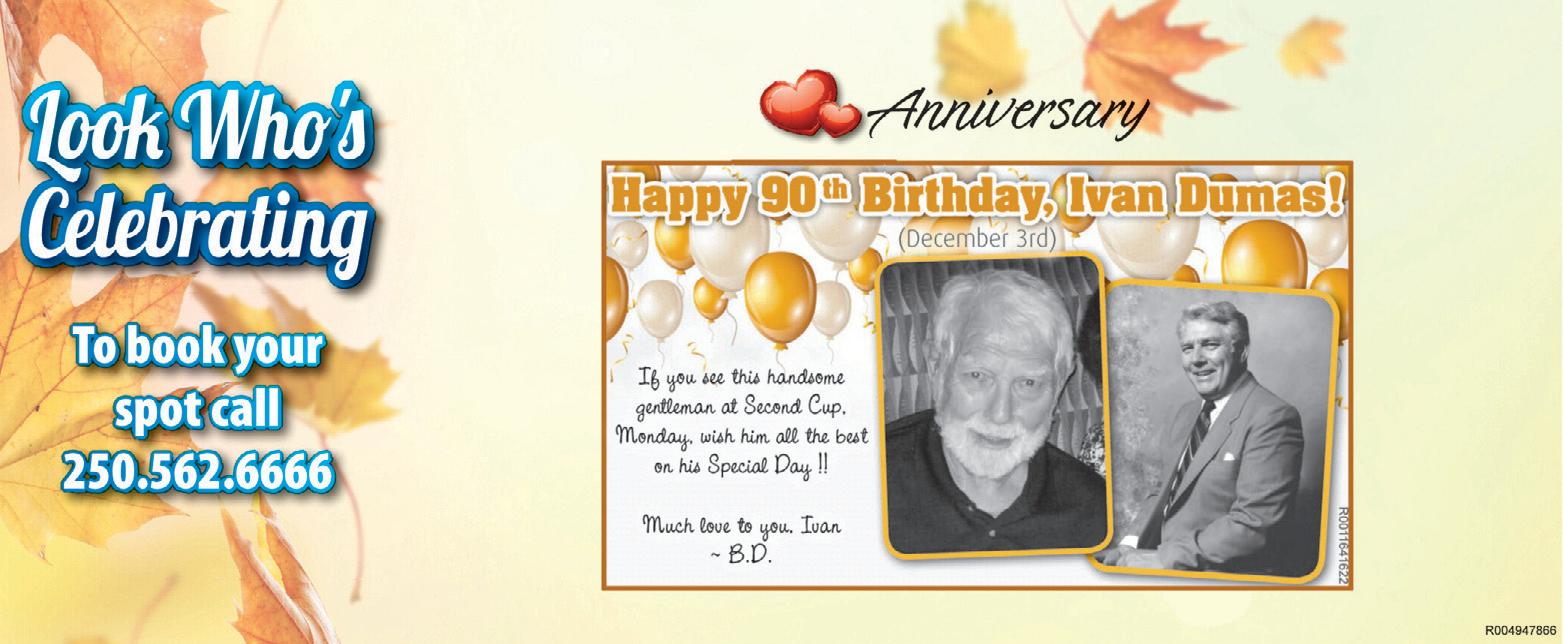
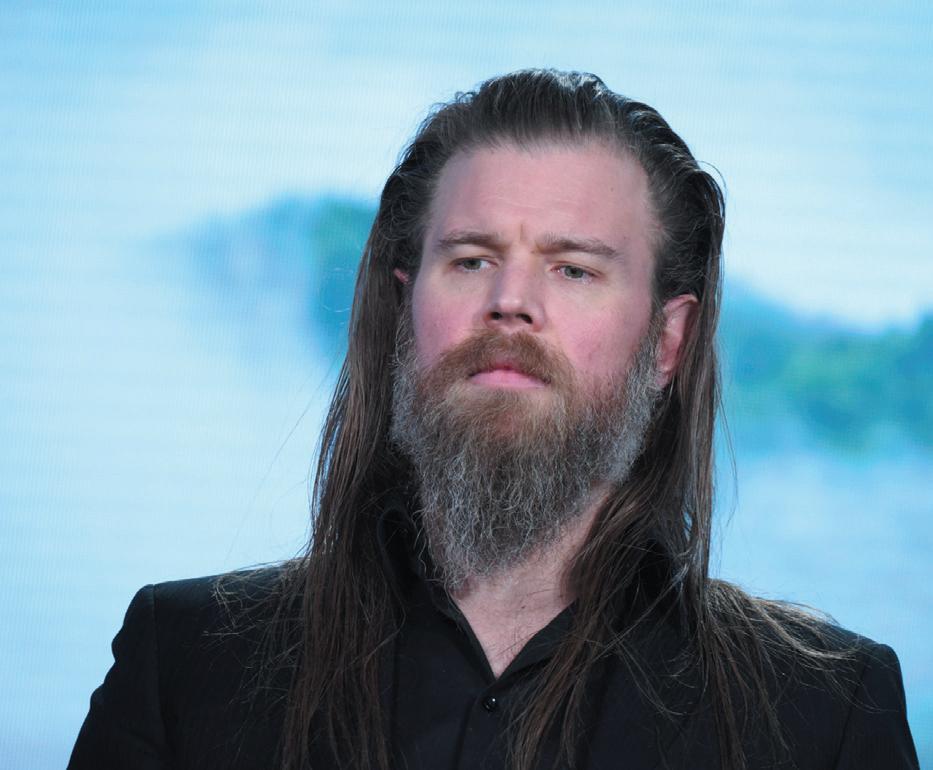
Frank PEEBLES Citizen staff
fpeebles@pgcitizen.ca
A son of anarchy is coming to Northern FanCon this May. The organizers of the popculture convention are giving the Prince George public a chance to meet one of TV’s hottest names. Some of the most fan-frenzied series on recent screens have involved this actor in prominent roles, and now he’ll be prominent at CN Centre. Ryan Hurst wasn’t just in Sons of Anarchy, he was one of the supporting stars with more than 50 episodes of screen time as Opie Winston. He followed that up with a starring turn as Chick Hogan, a pivotal series regular on Bates Motel. More critic’s gold was struck when Hurst became a regular on the most popular WGN Network series of them all when he portrayed L’il Foster Farrell on Outsiders. He was also a member of the
‘It
cast in the movies We Were Soldiers with Mel Gibson, Saving Private Ryan with Tom Hanks, Remember The Titans with Denzel Washington, Patch Adams with Robin Williams, and the Steven Spielberg mini-series Taken.
He contributed his voice to the animated hit movie Rango with Johnny Depp, and many more high-profile projects dating back to his first credit as Crunch Grabowski in Saved By The Bell.
His profile is about to get even grander when the new season of The Walking Dead turns a spotlight on a brand new character named Beta in a story arch called The Whisperers that got introduced this past week on the megapopular series.
“We are super excited to bring Ryan Hurst to Prince George, he is a highly recognizable face for fans, he has been a big part of really respected projects, and they are projects that our regular Northern FanCon attendees have told us
are important to them,” said chief organizer Norm Coyne.
The Walking Dead and Sons of Anarchy are two of those series to which the local public have responded well.
“We have had so much success with Sons of Anarchy guests in the past,” said Coyne.
“Kim Coates was one of our very first VIPs before FanCon even existed. Ron Perlman at the BCNE was another key guest star who worked with us early and helped us establish ourselves. They were pivotal to our future, so we have roots in Sons of Anarchy.
“We also had tremendous success with Alicia Witt, for example, and a lot of that had to do with her part on The Walking Dead, so that’s another series that means a lot to local viewers. They bring that to Northern FanCon.”
To get tickets to attend Northern FanCon (May 3-5), buy online at the TicketsNorth website or go to the CN Centre box office.
— from page 1
Felt reports are coming in as far away as 100 kilometres from the city, Cassidy said.
There have been no reports of damage.
On 105 Avenue in Fort St. John, Anne-Marie Freeman said the tremors shook the top floor of her condo building. “I thought the TV was going to fall over. Such a huge shake,” Freeman said.
Said Wendy Burkholder, “Out at the airport here, and I thought my walls were cracking.”
“Dawson felt it bad,” Samantha Zack said. “My work office white board came down even.”
Said Carol Alexander, “It shook hard and rumbled and rattled.” BC Oil and Gas Commission officials said they are investigating the matter.
The depth of the earthquake,
currently estimated between five to 10 kilometres, will be important in determining its cause, Cassidy said.
“Whether this is in any way induced or related to industrial activities we don’t know yet,” Cassidy said.
The tremors were felt at the Site C dam, under construction on the Peace River outside of Fort St. John.
“We’re doing a check of the construction areas,” Site C spokesman Dave Conway said.
There were no injuries on site, Conway said. Conway couldn’t say whether work at the site has halted.
Just downstream of the dam site is the riverside community of Old Fort, where a landslide occured in September and forced residents to evacuate their homes for more than a month before they were
allowed to return on Nov. 4.
The ministry of transportation has checked their monitoring equipment at the site of the landslide and there is no movement at this time, officials say.
Upstream of the Site C dam, are the WAC Bennett and Peace Canyon dams. Plant operators say there has been nothing of note related to the earthquake at their operations.
“We always do our due diligence, so our dam safety engineers are going over the data they have at this point,” BC Hydro spokesperson Bob Gammer said. “We have security doing site checks as well just to make sure.”
Cassidy is urging residents to fill out a report for Earthquakes Canada.
There have been more than 100 reports so far.
‘We need to be pursuing this’
— from page 1
“We can still cause them to change, hopefully, just by some pressure, to do the right thing,” he said and added Facebook seems willing to listen.
Zimmer conceded he never thought he’d be sitting on an international committee meeting in London grilling a key representative of one of the most influential companies on the planet. He came to the position as chair of the Canadian Parliament’s standing committee on access to information, privacy and ethics
which is meant to keep an eye out for ethics breaches by this nation’s government.
“But we had all come to an agreement that we need to be pursuing this,” Zimmer said.
NDP MP Charlie Angus and Liberal MP Nathaniel ErskineSmith were also in London for the committee meeting.
Zimmer said the international committee came into being as a Canada-UK initiative in the wake of the Cambridge Analytica scandal with a handful of other democratic countries joining on.
A professor considered a pioneer in the field of conservation decision making will be the keynote speaker when the B.C. Protected Areas Research Forum comes to UNBC next week.
Dr. Tara Martin will deliver a lecture entitled “Prioritizing Threat Management for Species Persistence within B.C.” at the Canfor Theatre on Monday, 7:30 p.m. start. The lecture is open to the public.
Under the Convention of Biological Diversity, Canada has committed to protecting 17 per cent of its terrestrial and 10 per cent of its marine and coastal areas by 2020.
“This will require more than just protection of any land or seascape, but rather protection of high quality habitat within and outside of protected areas and management of these areas for conservation outcomes,” said Martin, a professor in the department of forest and conservation sciences at the University of British Columbia.
Prior to taking on her position at UBC, Martin was a principal

research scientist with Australia’s National Science Agency where she founded and led the Conservation Decisions Team. Her work looks at combining ecological data with decision science to bridge the gap between research and on-ground conservation action and policy. The forum, meanwhile, runs from Monday to Wednesday. It is held every two years at a different venue around the province. The themes this year are Indigenizing conservation and climate changes and protected areas.
Frank PEEBLES Citizen staff
The Nechako Theatrics Community Society (NCTS) is holding a pantomime series that is already selling tickets like pirates grabbing loot. Treasure Island – A Ben Crocker Pantomime opened on Thursday and has performances again tonight at 6:30 p.m., Sunday afternoon (sold out), Dec. 7 and Dec. 8 (both at 6:30 p.m.).
“Join us for a spot of pirating in the sunny Caribbean. Laugh, sing and shout along with the adventure and excitement in this family-friendly, interactive British tradition,” said NCTS spokesperson Laura Lee Bennett. This theatre group is dedicated
The College of New Caledonia’s board of governors approved a two per cent domestic tuition and mandatory fees increase for the 2019/2020 academic year on Friday. A report released by the provincial government shows a two per cent annual increase for domestic tuition is standard for colleges in British Columbia.
“CNC remains the second lowest tuition at a BC college for a full-time academic arts program student,” college president
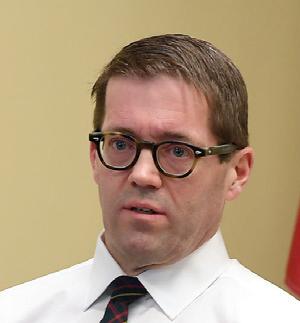
to inclusivity in local drama. “Nechako Community Theatrics is a community based theatre company, focused on making theatre open to everyone,” said Bennett. Tickets to the pantomime performances are available from Books & Company, from cast members, and at the door. Prices are $20 for adults, $10 for children (4-12), with kids three and under being free of charge.
There is also a group rate available if you email tickets@ nechakotheatrics.org for details. All shows are held at Artspace (upstairs at Books & Company). A concession is available before show and during intermission.
Henry Reiser said.
Elections BC is reminding voters to return their completed voting package for the referendum on proportional representation as soon as possible to ensure it is received by the Dec. 7 deadline. Completed packages should be returned in person at a Referendum Service Office or Service BC Centre. Some locations have extended hours, Saturday service, or a 24-hour drop-box. Find location and hours at elections.bc.ca/rso The deadline was extended by a week due to the Canada Post labour dispute.


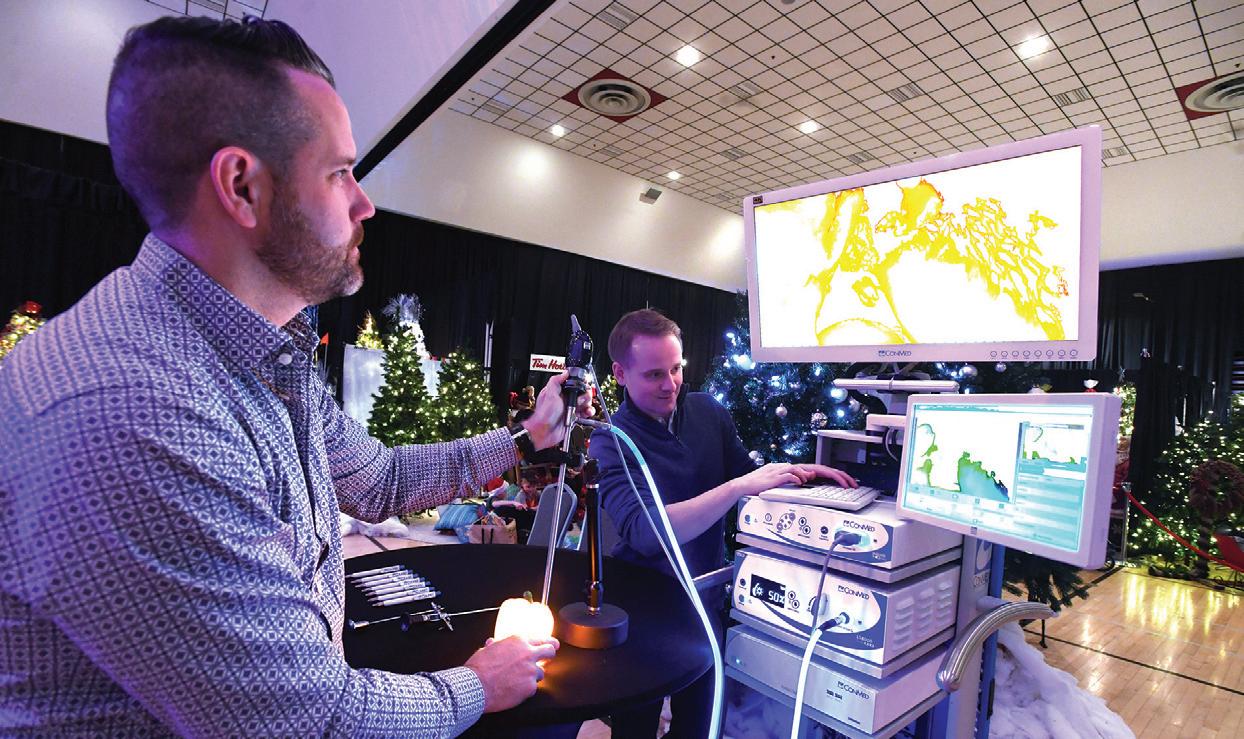
OTTAWA — The commissioner of the RCMP is offering the department’s “deepest sympathies” to the family of a former spokesman who an inquest heard experienced a deterioration of his mental health before he died by suicide in 2013.
A coroner’s inquest jury recommended this week that the RCMP evaluate its mental health strategy and offer a variety of methods for mental health education for its members after the death of Pierre Lemaitre, who was a sergeant.
The inquest heard that Lemaitre delivered the information he was told to give to the media about the death of Robert Dziekanski at Vancouver International Airport in 2007, and only learned later that a video contradicted some of his statements.
Sheila Lemaitre testified at the inquest in Burnaby, that her husband urged his supervisors to let him correct the information, but he was ordered not to and became deeply distressed by media reports calling him an RCMP spin doctor and liar.
Commissioner Brenda Lucki says in a statement issued Friday that she is committed to continuing to implement measures that support the mental health of RCMP employees and the force welcomes the recommendations made by the coroner’s jury.
Lucki says Lemaitre’s death is a tragedy that underscores the Mounties’ need to remain dedicated to investing in the health, well-being and safety of employees and families.
“Mental illness is a very real and urgent issue,” she says. “We must ensure that employees and their families are aware of, and can access, support programs and services. We need to proactively protect our members from the impacts of trauma and operational stress injuries, and foster a culture that supports those who are directly or indirectly affected by mental health issues.”
Lucki says the RCMP appreciates every opportunity to examine existing procedures and policies to ensure it is providing the best support to employees, and by extension, the best policing services to the public. She says it will review each recommen-
dation and provide a written response to the B.C. Coroners Service.
“For anyone who is suffering or needs help – reach out. You are not alone,” she adds.
Atoya Montague, a former media strategist for the RCMP, testified that Lemaitre was used to tell a false story about the death of Dziekanski, a Polish man who couldn’t speak English and became agitated after wandering around the airport arrivals area for 10 hours.
After the incident, Lemaitre told reporters that officers approached a combative man and jolted him twice with a Taser, but two days later the video emerged that showed Dziekanski was relatively calm when the Mounties arrived and that they used the stun gun five times.
The inquest jury made five recommendations, including calling on the RCMP to conduct mental health assessments in conjunction with the department’s three year mandatory physical assessment and to provide classes to family members after an officer is hired to provide an overview of the potential mental health issues they could face.
Adam Hughes and Geoff Borgmann Conmed demonstrate one of the Conmed video towers at the Festival of Trees on Friday by placing the probe into a yellow pepper. The Spirit of the North Healthcare Foundation is raising funds for four orthopedic OR video towers.
Elaborate holiday displays can result in big bills, BC Hydro says
VANCOUVER — BC Hydro is warning homeowners who string up elaborate holiday lighting displays that those decorations can significantly boost power costs.
A new report from the Crown utility says the outdoor lighting load plummeted about 40 per cent by 2011 as LED lights replaced incandescent bulbs, but a trend toward larger displays has increased the load by 15 per cent since then.
Popular inflatable holiday decorations are among the worst offenders because Hydro says they are typically run day and night.
The BC Hydro report finds nearly 60 per cent of households put up holiday lighting and one in five of those households uses at least eight strands of lights.
Hydro also estimates that about one-third of lights still in use are energy-gobbling incandescents, and says if the infamous holiday display in the film National Lampoon’s Christmas Vacation were incandescent, it would cost $4,700 to light. The report says that bill would drop to about $50, if the lights were LED and it urges Hydro customers to switch to the energy efficient version.

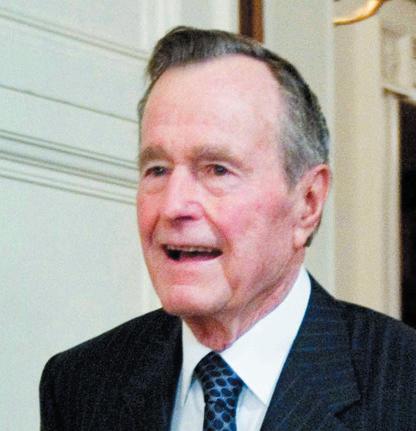
Michael GRACZYK Citizen news service
HOUSTON — George H.W. Bush, a patrician New Englander whose presidency soared with the coalition victory over Iraq in Kuwait, but then plummeted in the throes of a weak economy that led voters to turn him out of office after a single term, has died. He was 94.
The Second World War hero, who also presided during the collapse of the Soviet Union and the final months of the Cold War, died late Friday night at his Houston home, said family spokesman Jim McGrath. His wife of more than 70 years, Barbara Bush, died in April 2018.
The son of a senator and father of a president, Bush was the man with the golden resume who rose through the political ranks: from congressman to U.N. ambassador, Republican Party chairman to envoy to China, CIA director to twoterm vice-president under the hugely popular Ronald Reagan. The 1991 Gulf War stoked his popularity. But Bush would acknowledge that he had trouble articulating “the vision thing,” and he was haunted by his decision to break a stern, solemn vow he made to voters: “Read my lips. No new taxes.”
He lost his bid for re-election to Bill Clinton in a campaign in which businessman H. Ross Perot took almost 19 per cent of the vote as an independent candidate. Still, he lived to see his son, George W., twice elected to the presidency – only the second father-and-son chief executives, following John Adams and John Quincy Adams.
The 43rd president issued a statement Friday following his father’s death, saying the elder Bush “was a man of the highest character.”
“The entire Bush family is deeply grateful for 41’s life and love, for the compassion of those who have cared and prayed for Dad,” the statement read.
After his 1992 defeat, George H.W. Bush complained that media-created “myths” gave voters a mistaken impression that he did not identify with the lives of ordinary Americans. He decided he lost because he “just wasn’t a good enough communicator.”
Once out of office, Bush was content to remain on the sidelines, except for an occasional speech or paid appearance and visits abroad. He backed Clinton on the North American Free Trade Agreement, which had its genesis during his own presidency. He visited the Middle East, where he was revered for his defence of Kuwait. And he returned to China, where he was welcomed as “an old friend” from his days as the U.S. ambassador there.
He later teamed with Clinton to raise tens of millions of dollars for victims of a 2004 tsunami in the Indian Ocean and Hurricane Katrina, which swamped New Orleans and the Gulf Coast in 2005. During their wide-ranging travels, the political odd couple grew close.
“Who would have thought that I would be working with Bill Clinton, of all people?” Bush quipped in October 2005.
Bush was born June 12, 1924, in Milton, Mass., into the New England elite, a world of prep schools, mansions and servants seemingly untouched by the Great Depression. His father, Prescott Bush, the son of an Ohio steel magnate, made his fortune as an investment banker and later served 10 years as a senator.
Bush enlisted in the Navy on his 18th birthday in 1942, right out of school. Lean and athletic, Bush became a war hero while still a teenager. One of the youngest pilots in the Navy, he flew 58 missions off the carrier USS San Jacinto.

Kristy KIRKUP Citizen news service
BUENOS AIRES, Argentina — Canada is confident it will win legal challenges to American steel and aluminum tariffs that remain despite the new NAFTA deal, Foreign Affairs Minister Chrystia Freeland said Friday in Buenos Aires following a high-profile signing ceremony for the trade treaty.
“We do not accept the legality of these tariffs,” she said. “We have challenged and are continuing our legal challenges. We think this is simply wrong and frankly, we are very confident we are going to win those legal challenges.”
Freeland’s remarks offer a glimpse into the political and legal heavy lifting set to follow Friday’s signing of the trade pact –an agreement reached through handwringing negotiations and a ceremony confirmed only at the 11th hour.
U.S. President Donald Trump conceded Friday the process to reach the United-States-Mexico-Canada Agreement, or USMCA, was a battle but went on to say that “battles sometimes make great friendships.”
Canadian officials had insisted Canada would not take part in a signing ceremony unless the steel and aluminum tariffs were lifted. Trump imposed them in June, ostensibly on the national-security grounds, and has refused to budge on them.
But Canada’s refusal to sign the deal with the tariffs in place softened this week, said one insider: “At the end of the

day, removing the uncertainty from the rest of the economy is too important to pass up.”
In his remarks Friday, Prime Minister Justin Trudeau stressed the importance of locking down an agreement while he stood with Trump and outgoing Mexican President Enrique Pena Nieto.
Signing on to the three-way trade agreement alleviates the serious economic uncertainty that lingered throughout the negotiations, Trudeau said, adding uncertainty would have only caused more economic damage had the deal not been reached.
“There’s much more work to do in lowering trade barriers and in fostering growth that benefits everyone,”
Trudeau said. “As a result (of the new agreement), the tariff-free access NAFTA guaranteed for more than 70 per cent of Canada’s total exports is secure. That’s essential for businesses, families, jobs, entrepreneurs, and hardworking people in every corner of our country. ” Trudeau raised the tariff issue with Trump before the three leaders emerged together for the signing ceremony, said officials in the Prime Minister’s Office.
A Canadian official also said that the big advantage of signing onto the agreement now is a side letter on the auto industry, which exempts Canada from potential tariffs on exports of up to 2.6 million vehicles – well above current levels.
Friday marked an important deadline for the trade pact because a new Mexican president takes over today who might not honour the tentative deal struck by his predecessor.
Trump acknowledged that Friday was Pena Nieto’s last day in office and congratulated him on the achievement of signing on to the deal.
The signing of the three-way trade pact is largely ceremonial because it still needs to be ratified by all three countries before it can formally take effect.
U.S. lawmakers have already indicated they don’t expect to tackle the USMCA – or CUSMA, as Ottawa now calls it, except when calling it the “new NAFTA” – until after the new Congress is sworn in early next year.
— With files from James McCarten


Earlier this year, I witnessed a profound historic moment at the International AIDS Conference in Amsterdam.
Dr. Alison Rodger, a leading HIV researcher in the United Kingdom, presented the final results from a study of couples with one HIV-positive and one HIV-negative partner. After eight years of the study, she reported, there were zero cases of HIV transmission from one partner to the other – thanks to the prevention benefits of modern HIV medications.
The evidence has been mounting for years. Several large clinical trials have confirmed that HIV treatment can suppress the virus so successfully that sexual transmission doesn’t occur. Three-quarters of Canadians diagnosed with HIV have already achieved this level of viral suppression, and this number could grow even further by linking people to treatment and care. The reality is that most Canadians who are living with HIV today can’t pass the virus on to their sexual partners.
So if most Canadians living with HIV can’t
pass it on, why are there still more than 2,000 new infections in our country every year? Research tells us that most HIV transmissions originate from people who think they are HIV-negative but have recently contracted the virus – the undiagnosed.
There are a few reasons for this.
First, when someone acquires HIV the virus is circulating through the body at its highest levels, making the person more likely to pass it on.
Second, a person who has been diagnosed is more likely to take measures to prevent passing it on to their partners. And finally, we now know that an HIV-positive person on effective treatment does not transmit the virus sexually.
expanding access to testing.
Yet across the country, barriers remain. Many people have never been tested for HIV, or don’t test as often as they should. Sometimes this is because they don’t perceive themselves to be at risk, sometimes it is because of the stigma around HIV, and sometimes it is because testing clinics are difficult to access. Some places in Canada and abroad have shown us how we can do better.
More than 9,000 Canadians are estimated to be living with undiagnosed HIV, and this is where most new infections originate.
In British Columbia, an online service allows people to order routine HIV tests online and submit samples directly to a lab, bypassing clinic lineups.
from rural and remote locations. In the United Kingdom, free HIV self-testing kits can be delivered to your mailbox, and many regions and countries have employed community educators to offer HIV tests to their peers, free of stigma and judgment. These initiatives have only been possible with the support and funding of governments committed to ending their respective HIV epidemics.
We have seen shining examples from communities across the country and around the world making great strides to reach the undiagnosed. Yet at a national level, Canada is falling behind other countries in the adoption of these approaches, and this has meant slow progress in reaching the undiagnosed – and a greater likelihood of new infections continuing unabated.
More than 9,000 Canadians are estimated to be living with undiagnosed HIV, and this is where most new infections originate.
To effectively respond to this hidden HIV epidemic, we must focus our efforts on
In Saskatchewan, routine HIV testing is offered for all teenagers and adults every five years through both primary and emergency health care. Dried blood spot testing has been introduced in some First Nations to overcome some of the barriers to drawing blood and transporting samples

Can’t we just get rid of...
wesome is awful.
A“A perfectly good word rendered meaningless by everyone using it all the time when so many other words would be more suitable,” opined
Lori Hamilton, awesomely.
She was, in fact, one of a handful of people to cite awesome as a word she would gladly never hear again. She was one of numerous individuals who wrote to me after my recent column, which was about nature-related words that had disappeared from a dictionary. Some readers suggested words they wished would vanish and, conversely, others pointed to words they would like to see return. Here are some of their replies:
• “I can’t wait to see the back of iconic,” declared James Fife.
• Overworked adjectives also irk Roy Leaman. “Fantastic article, Jack. Oops, I stopped using the word fantastic years ago.”
• Rich diversity leaves Derek Tant feeling poorly.
• Sheryl Taylor-Munro wishes opioid overdose would become obsolete. Amen.
• Andy Haden is tired of “military-grade anything.” As in the marketing term emphasizing the toughness of everything from flashlights to the aluminum in pickup trucks.
• Jim Sexton would like to crowbar leverage out of the lexicon. “Ugh. Hideous. Even ‘to lever’ would be better.” Sexton also finds the use of concerning as an adjective, um,
conce.... No, no, why use the C-word when the perfectly good troubling or unsettling are available?
• For Judy Nobel, it’s usage that rankles. “Wheresitat for where is it. WhereamIat for where am I. Then I love bringwith for bring it with you.”
• Rex Sharman flinches at impact as a verb. (“How about reverting to ‘affect’ or ‘influence?’”)
• “Growing the middle class,” impacts Patricia Cuthbertson negatively.
• “My cringe word is gotten,” wrote Bruce Beattie.
• Gotten also galled Sam Kanczula. “This word is used to replace so many more descriptive words that would not butcher the English language.
“He’s much better now” is much better than “He’s gotten better.”
“He’s received his mail” trumps “He’s gotten his mail.”
Speaking of the T-word:
• Trump, humphed Sharon White, monosyllabically.
• “I look forward to the time that trump will only refer to playing cards,” wrote a wistful (whistful?) Alexis MaartmanJones.
• Trump and its derivatives also irked Andy House, as did libtard, bigly and a few other associated terms (in which case Andy might avoid reading the Fox News Facebook page). What words would he prefer to read?
“I’d like to see faith, and hope and charity, along with optimism and civility, come back into common usage.”
• Derek Byer also submitted both naughty and nice lists. He would happily wave farewell to misremember, bike lanes and fake news, but yearns for the return of gazooks, wanker, milady and bollocks, which I think is the name of the Sex Pistols’ greatest hits album.
• Cam Purdy misses gallivant, spiffy, gadabout, dandy and Barack Obama.
• Shelby Alfred mourned infra dig. “Used extensively in the Victorian era, it describes an action or a statement that was socially demeaning.
“For example, for a married man to publicize the fact that he had a mistress was distinctly infra dig.”
• “I miss scrivener,” lamented Victoria author Ian Ferguson. In case you’re wondering, a scrivener was a scribe, someone who made a living by writing or copying written material. I have occasionally scrivened Ian’s ideas. (That sounds nicer than plagiarism.)
• Byron Macadam’s lost word was one he learned from his grandmother in the late 1950s, but doesn’t recall hearing again until his daughter used it in a recent email: discombobulated, meaning confused or frustrated.
“I suppose it could mean that one is not ‘combobulated,’ but I doubt if that is a word, though I have been wrong before.”
Thanks to all who replied. You were awesome.
This World AIDS Day, I urge governments and leaders to take their calls for awareness one step further and turn them into action. Let’s do more than encourage testing. Let’s make it possible.
— Laurie Edmiston is executive director of CATIE, Canada’s source for HIV and hepatitis C information
Resuming a debate that has arisen occasionally in the past, some schools have announced that they will no longer require applicants to provide standardized test scores, but instead will look to high school grade-point averages and subjective information.
The institution I lead, Purdue University, will not be joining that group. Accepting a high school A at face value and enrolling a student in a calculus course beyond his or her capabilities does the student a serious disservice by risking an avoidable failure.
Still, assigning greater weight to high school grade-point averages has its merits. In many cases, the GPA proves to be a reliable indicator of discipline, persistence and resilience – characteristics necessary to succeed at the postsecondary level (to say nothing of adult life). In the current vernacular, these traits are often collectively called “grit.” Enrolment experts agree on its significance. The problem is in knowing when a high GPA reflects it and when it doesn’t.
The challenge for today’s admissions officer is like the one faced by corporate recruiters: In an era of rampant grade inflation, which grades can you believe? Businesses began learning years ago not to put much stock in diplomas from schools where the average graduate’s GPA is 3.5 or higher and may not be at all indicative of real learning or readiness for the modern workplace.
Last year, researchers reported that nearly half of American high school seniors in 2016 – 47 per cent – graduated with an A average. That’s up from 38.9 per cent in 1998. As ordinary students increasingly “earn” higher marks, teachers help top students stand out by granting them extra credit of various kinds. The result: It is now not unusual for colleges to see high school GPA averages above a “perfect” 4.0.
It is increasingly clear that, though a strong high school GPA may indicate “grit,” it can also just be a sign of lax grading –producing not resilience but its opposite.
The emotional fragility of many young people today is, by now, a well-documented phenomenon. College students’ psychological problems, and genuine mental illness, are very real; every school I know of approaches the matter with utter seriousness and responsibility. Running a college
or university necessitates evergrowing numbers of counselors and therapists, but keeping up can be difficult. Requests for appointments start almost as soon as a new class arrives. This fall at our school, at least one freshman sought a counseling session before setting foot on campus.
The trend has spawned a host of explanatory theories. Many have pointed to parental overprotectiveness as the primary cause, and, no doubt, that is a real factor. In the new book The Coddling of the American Mind, co-authors Jonathan Haidt and Greg Lukianoff write that many young people, having too rarely handled problems or adversity on their own, now instinctively run, looking for an adult at the first whiff of difficulty.
On campuses, one sees plenty of support for the authors’ contention. Calls and emails from worried parents – not only to the student but directly to university offices – are a daily fact of life. The phrase “helicopter parent” is no longer adequate; now you hear about “lawnmower parents.”
Many problems brought to our counselors are of social origin – loneliness, cyberbullying, just plain homesickness – but many others stem from academic anxiety, and small wonder. Firstyear students who rarely saw a B during their K-12 years can be severely jolted when handed back a paper marked C. Too many participation trophies when growing up is a lousy preparation for life at a reasonably rigorous university, let alone in the real world beyond.
Of course, one easy solution for post-secondary institutions is just to go with the grade-inflation flow, and obviously many institutions of higher education have chosen that route. Places determined instead to stretch and challenge students, aiming to help them achieve their full potential, will have to take on the trickier task of identifying and fostering true grit, providing quality counseling everywhere it’s needed without worsening what is already an overly therapeutic culture.
Meanwhile, let’s hope someone comes up with a new GPA – Grit Potential Assessment. I guarantee you, our university will be the first customer.
– Mitch Daniels is president of Purdue University and a former governor of Indiana
LETTERS WELCOME: The Prince George Citizen welcomes letters to the editor from our readers. Submissions should be sent by email to: letters@pgcitizen.ca. No attachments, please. They can also be faxed to 250-960-2766, or mailed to 201-1777 Third Ave., Prince George, B.C. V2L 3G7. Maximum length is 750 words and writers are limited to one submission every week. We will edit letters only to ensure clarity, good taste, for legal reasons, and occasionally for length. Although we will not include your address and telephone number in the paper, we need both for verification purposes. Unsigned and handwritten letters will not be published. The Prince George Citizen is a member of the National
Council, which is an independent organization established to deal with acceptable journalistic practices and ethical behaviour.

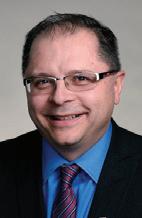
Mailing
General news: news@pgcitizen.ca
Sports inquiries: 250-960-2764 sports@pgcitizen.ca
Classifieds advertising: 250-562-6666 cls@pgcitizen.ca
Director of Advertising: Shawn Cornell 250-960-2757 scornell@pgcitizen.ca Reader sales and services: 250-562-3301 rss@pgcitizen.ca Letters to the editor: letters@pgcitizen.ca
Website: www.pgcitizen.ca
Website feedback: digital@glaciermedia.ca
Member of the National Newsmedia Council A division of Glacier Media


Jeannette Lee FALSEY, Mark BERMAN and Angela FRITZ Citizen news service
ANCHORAGE, Alaska — Chris Riekena was driving with his seven-year-old son when the road beneath their car began to shake.
Riekena, an engineer with the state Department of Transportation, thought he blew a tire, so he pulled to the shoulder. Then he saw the row of streetlights above him swaying and he saw the red SUV in front of him sink into the road.
A severe earthquake, rated 7.0 on the moment-magnitude scale, ripped across the Anchorage area Friday at 8:29 a.m., Alaska Time. Buildings roiled, roads cracked and thousands lost power during the morning commute. Dramatic scenes like the one Reikena witnessed on Minnesota Drive played out across the highest populated city in Alaska.
The SUV “sank, and then it sank some more. It was a slow process – about 30 to 40 seconds,” Riekena said as a National Guard helicopter passed overhead.
“In a way it was exciting and it wasn’t because it was so slow.”
The off-ramp he and his son were just driving on had buckled into a dozen massive slabs of asphalt. The driver of the red SUV walked away unharmed, Reikena said.
Local and state officials spent the rest of the day assessing damage, the extent of which remained unclear Friday afternoon, though it included “major infrastructure damage across Anchorage,” according to the police department. Utility companies and cooperatives reported more than 50,000 customers lost power on Friday, though the number of outages fell as the day went on and electricity was restored.
Jeremy Zidek, a spokesman for Alaska’s state Division of Homeland Security and Emergency Management, said the situation was still evolving while aftershocks continued.
“Right now, we’re asking people to drop, cover and hold on when they feel earthquakes,” he said.
Anchorage Fire Chief Jodie Hettrick said at a briefing authorities were contacted about possible building collapses, but she did not provide more information. The Alaska Department of Transportation said that due to reports of damage in Anchorage as well as surrounding areas, crews were sent out to inspect roads and bridges. The earthquake cracked and otherwise damaged highways, while a rock slide shut down one highway.
Michelle Tobia, the manager at Bell’s Nursery in Anchorage, was in her two-storey house next to the store when the earthquake hit. “The whole house was rolling is what it felt like,” Tobia said. She grabbed her dog, Daisy, a husky-Labrador mix, and ran upstairs to shelter under a door frame. After the shaking stopped, “stuff was

everywhere,” she said.
“Glasses off the counter tops, DVDs spewing out of the TV stand.”
The plant nursery next door was dark and the parking lot empty. Inside, a cleaning crew was picking up pots of poinsettias and toppled Christmas trees. Tobia said she was confident they would reopen by the afternoon when the lights were back on and employees had a chance to clean up their own homes.
Police officers were dispatched across the region to handle “multiple situations,” the department said. A journalist with the news station KTVA shared a photo of the damage in that newsroom, where pieces of the ceiling had apparently fallen on desks and the floor. The Minnesota Drive off-ramp near Ted Stevens Anchorage International Airport drew a string of spectators.
Keri Scaggs and her neighbour RieAnn Fullwood snapped selfies in front of the collapsed road as a third neighbour, still in her bathrobe, waited for them in the car. Scaggs clutched a bottle of Kentucky bourbon, while Fullwood snuggled her cat. The pair fled their cabins in the Spenard neighbourhood after the tsunami warning.
“I grabbed the essentials,” Scaggs said.
“Birth certificate, passport and Pappy Van Winkle,” she said, cradling the bourbon bottle in the crook of her elbow.
The FAA had declared a ground stop at the airport after the earthquake.
At 11:30 a.m. in Anchorage, the FAA said it had begun letting flights depart from the
airport, but the ground stop was kept in place for arrivals.
Samuel Shea, the Science Operations Officer at the National Weather Service in Anchorage, said his drive from the office to his home in South Anchorage, which usually takes around 10 minutes, was 40 minutes on Friday after the earthquake.
“It was terrifying,” Shea said.
“I mean, we have magnitude fives, sixes –we deal with earthquakes all the time, and this was the strongest I’ve ever felt, and the most terrifying minute of my life.” Several hours after the initial quake, aftershocks were still rolling across the region, and “it just stops your heart” when they happen, he said.
The National Weather Service in Anchorage briefly suspended operations on Friday morning after the tsunami warning was issued. All of the office’s duties were handed over to the Fairbanks office, and the meteorologists and staff evacuated. Operations resumed at the Anchorage office after the warning was canceled.
The earthquake hit as students were on their way to school, about 30 minutes before classes would start. The Anchorage School District canceled classes on Monday and Tuesday while it assessed damage to its facilities.
“Take care of your families,” the district’s superintendent, Deena Bishop, wrote on its website.
The University of Alaska Anchorage closed its campus on Friday after the earth-
quake, urging all nonessential personnel to leave and warning people to stay away from the campus.
Chancellor Cathy Sandeen posted online that while the university sustained some damage, there was “no word of injuries, thankfully.” She also posted a photograph showing the damage to one of the rooms on campus, which was littered with ceiling tiles that had fallen down.
The U.S. Geological Survey estimates a low probability of fatalities from the earthquake. Estimated economic losses are most likely between $100 million and $1 billion, which is an “orange alert,” according to the survey’s algorithms. “Past events with this alert level have required a regional or national level response,” the center said on its website.
Friday’s quake occurred on a fault line between the Pacific and North American tectonic plates, the USGS said. The rupture between the faults occurred in an area where the Pacific plate is moving underneath Alaska.
The National Tsunami Warning Center often issues advisories immediately following an earthquake on a high-risk fault line, such as the one underneath Anchorage, like it did Friday morning. The center then revises the warnings based on observations.
Dozens of aftershocks rippled across the region through Friday afternoon, according to the USGS, including a 5.8-magnitude in the city of Anchorage.
Citizen news service
VANCOUVER — Two employ-
ees of the fire department in Vernon are battling to keep their jobs after a videotape showed them having sexual relations in the interim fire chief’s office.
The pair, who are not named, were fired two days after the incident earlier this year, but their union is grieving the dismissals.
It argued the camera was hidden and its footage amounts to “an illegal collection of personal information” that should not be used against the employees.
“The union does not deny the two employees engaged in the activity recorded in the footage, which the union characterizes as ‘a deeply personal and compromising interaction,’ ” says the
decision. But it says the union did not agree to an admission of the activity as part of the arbitration process, asserting the employer has a legal onus to prove each employee engaged in activity that justified their firing.
The camera had been installed several months earlier after David Lind, who was the interim chief at the time, became concerned that someone might be accessing his locked file cabinet, which contained sensitive staffing and budget documents.
Video didn’t show a staff member accessing the file cabinet and the union applied to have the pictures excluded as evidence in the termination proceedings, but an arbitration ruling issued on Oct. 30 disagrees. A majority ruling by two of the
three arbitration panel members found the “surreptitious surveillance” was both necessary as part of an investigation of alleged employee misconduct and a “reasonable exercise of management authority.”
Union grievances of the firings were scheduled to be held last week, with the video permitted as evidence.
The city said in a news release on Friday that the case involved a firefighter and another employee of the fire service.
“Because this incident is before an arbitration panel, no additional information will be made available from the city at this time,” it said.
In reaching their decision, arbitration panel chair James Dorsey and employer nominee
John McKearney found the video footage was not a serious invasion of privacy.
“The brief, fleeting loss of privacy by individual firefighters ... was at the lower end of any range of seriousness of invasion of privacy at work,” the decision says.
But Lorne West, the union nominee on the panel, wrote in a dissenting opinion that consideration is needed of the troubled labour management atmosphere in the fire department, where Lind had arrived as part of a complete turnover of department leadership barely a year earlier.
The decision says when Lind was hired, he was “told there were relationship challenges” in the department.
“The explicit message was to be cautious trusting union leader-
ship,” it says.
When Lind found the lock of his file cabinet in the unlocked position after he was sure he locked it, the arbitration decision says he and the deputy chief “speculated the most likely culprit was a union representative.” It says Lind and the deputy chief decided to install camera surveillance.
The panel says it shares “some of the union’s concerns” about Lind’s testimony, but West goes further, writing it was “not believable.”
“If there is no truth to interim fire Chief Lind’s testimony then there can be no justification for the video camera installation. Therefore, the video footage should not be admissible,” wrote West.


Rebecca RITZEL Citizen news service
Dan Laroche holds a slight grudge against the United States. Every day when he goes to work as site supervisor at Fort George in southern Ontario, he can stare across the Niagara River and into western New York, and think to himself, “Those Americans stole our flag.”
“Our flag” would be the British banner that waved above Fort George in May 1813, when the garrison was captured by the Americans after three days of intense fighting about 32 kilometres upstream from Niagara Falls. Six months later, the Americans burned the town surrounding the fort and retreated back across the river into American territory, taking a tattered Union Jack with them.
Laroche would like it back. It’s only fair. Because after the Americans fled, British forces not only retook Fort George, they easily captured Fort Niagara on the U.S. side of the river. The American garrison’s flag was transported to London and presented before King George III. And then for nearly 200 years, the Scottish descendants of a War of 1812 general proudly held onto that looted Stars and Stripes. In 1994, the family matriarch – an aristocrat romance novelist named Lady Strange – sold it back to Fort Niagara to fund a new roof for her castle. Since 2005, the 12-by-27-foot StarSpangled Banner has been on display in Fort Niagara’s visitors centre.
“When I heard they got it back, I thought, ‘Hey! That’s our war prize,’” Laroche said. He was joking. Mostly. But the Fort George flag was reportedly last spotted at the U.S. Military Academy (West Point). If anyone in America sees it, please let Canada know.
Capture-the-flag anecdotes aside, Fort George and Fort Niagara are significant historical sites because they represent one of a few locations where the two countries battled from sovereign shores, and the only spot along the 8,891-km U.S.-Canadian border where opposing forts still stand. You could say they are monuments to bygone days, an era when the United States and Canada weren’t getting along.
Or you could listen to the news to hear an update on fractious trade negotiations, or to hear Homeland Security officials warn Canadians who work in the cannabis industry not to cross the border, or to hear U.S. President Donald Trump proclaim at a news conference, “Canada has treated us very badly.”
And then you might wonder: Is the relationship between the United States and Canada the worst it has been since the War of 1812?
“Heaven knows, that’s true; things haven’t been this bad in a very, very long time,” says Robert Bothwell, a professor of history at the University of Toronto who specializes in U.S.-Canadian relations.
He noted that a recent nonpartisan Angus Reid poll showed fewer than half of all Canadians have a favourable view of the United States after “two years of volatile trade negotiations and insults.”
That’s very different from the height of the Iraq War, when Canadians disapproved of President George W. Bush but still thought favourably of the United States as a country.
Bothwell says he despises Trump, but he and his colleagues who study the War of 1812 are enjoying a slight bump in attention thanks to the current war of rhetoric.
Last summer, he called a friend, Pulitzer Prize-winning historian Alan Taylor, with some exciting news.
“You just got quoted by the Canadian foreign minister in one of her trade speeches!” Bothwell recalled saying to Taylor, who teaches at the University of Virginia.
While it’s unlikely that Fort George and Fort Niagara can attribute increased attendance to throwback political tensions, both sites report that the numbers are up. At Fort Niagara, which is operated by a nonprofit group and surrounded by a gorgeous state park, attendance has more than tripled from 70,419 a year in 2011 to 253,000 in 2017.
“It helps pay the bills,” says Robert Emerson, a military historian who serves as executive director of the Old Fort Niagara Association.
portrayed in the musical Hamilton as a pair of conspiratorial drinking buddies – were convinced that English-speaking residents of what is now Ontario would want to join the union.
“The acquisition of Canada, as far as the neighbourhood of Quebec, will be a matter of mere marching,” Jefferson boasted in August 1812.
He was wrong.
On Oct. 13, 1812, Americans crossed the Niagara River and encountered British, Canadian and First Nations forces at the Battle of Queenston Heights, just south of Fort Niagara and Fort George. It was the first significant engagement, and it was an American defeat.
More than 500 American men were killed or wounded and nearly 1,000 were taken prisoner, according to historian Carl Benn, who has written several books on the War of 1812.
Over the course of the War (of 1812), a dozen U.S. armies cross the border in an effort to turn us into another state of the union. As we’re still standing on Canadian soil, you can decide for yourselves how they do.
— Tour guide Heather Collacott
Parks Canada, which operates Fort George with help from a nonprofit group called the Friends of Fort George, declined to report specific figures but confirmed that visitors are on the rise. Both forts are open year-round, and both charge a small admission fee. They are the ideal place to get a crash course on U.S.-Canadian relations that you won’t get from watching the news. For starters, as soon as an American steps inside Fort George’s stockade, you’ll hear a very different narrative about the War of 1812 than what you heard in school.
“In June of 1812, the United States of America declares war on Great Britain. Canada is still a British colony and a heck of a lot closer, so this becomes the battlefield,” explains ghost tour guide Heather Collacott on a blustery and moonlit October night. Collacott stamped her heavy booted foot. Her lantern bobbed, and she swished her black cape with pride.
“Over the course of the war, a dozen U.S. armies cross the border in an effort to turn us into another state of the union. As we’re still standing on Canadian soil, you can decide for yourselves how they do.”
The concept of the war as an “invasion” of Canada may be foreign to any American who grew up hearing stories of the British burning the White House and the banner yet waving over Fort McHenry.
And yet at Fort George, excellent exhibits inside a reconstructed blockhouse make clear that’s exactly what President James Madison intended. Both Madison and his predecessor, Thomas Jefferson – aptly
On the opposing side, however, 104 troops were killed or wounded, and among the men fighting for the British were about 250 First Nations people and a 50-man brigade of freed slaves and black servants.
But British priorities eventually shifted south. Meanwhile, the U.S. Navy had built a fleet on the American side of Lake Ontario.
In May 1813, American forces heavily bombarded Fort George from Fort Niagara and held Fort George for an uneasy six months. Then one December day, they went around knocking on doors and suggested that the Canadians should leave, because they were about to burn the place down.
“It’s likely no one believed them,” Bothwell said. “That just wasn’t done back then.”
The next day the American occupiers were back, torches in hand. And when the British forces followed them across the river a few weeks later, on Dec. 19, they returned the favour by burning Lewiston, N.Y., to the ground.
Some historians say the torching of homes surrounding Fort George led to the eventual burning of Washington. In 1813, Lewistown was much bigger than Buffalo and considered a gateway to the West. Now, it’s a small hamlet full of touristy shops and microbreweries; each December, some residents re-enact the midnight torching by running down the street in pajamas.
Bothwell describes such War of 1812 commemorations as “rather quaint.”
Serious military exercises continued at the mouth of the Niagara River long after the 1814 Treaty of Ghent. On the Canadian side, Fort George was allowed to deteriorate because the garrison was so close to other active military instillations, including Butler’s Barracks, Fort Erie and Fort Mississauga. Only the gunpowder magazine dates
to 1796. Replicas of other buildings were built mostly on original foundations as part of an economic stimulus during the Great Depression.
Fort Niagara has been well preserved, however, and was even expanded during the Civil War when the Union feared that Canadians might align with the Confederacy. During the First World War, both countries trained soldiers in models of European trenches, which visitors can still crawl through. During the Second World War, Fort Niagara served as a POW internment camp and dispatched German soldiers to work at western New York farms.
“For years, some of them still called me each Christmas,” said Emerson, who has led the historical site since 1997.
The fort was busy even on a chilly fall Saturday. In addition to lowering and folding the American, French and British flags that fly over the fort, a troop of Boy Scouts was tasked with chopping onions and preparing stew in the bakehouse, which began feeding soldiers in 1745. The medieval-looking main building, known as the French Castle, was built in 1729, and the land has served as some sort of military installation since the French claimed it in 1679. (The English took over after the French and Indian War, and the fort officially became American property once John Jay’s Treaty took effect in 1796.)
“We were built by King Louis XVI and decommissioned by JFK,” Emerson says. “That is a very, very long run.” German tourists stopped Emerson to ask questions as we looked out at the Toronto skyline from the North Rideout tower, which surely has one of the most stunning views on all Lake Ontario. From the South Rideout, Emerson can just make out the Union Jack flying on the east side of Fort George.
“We used to be able to see more of the fort, but about 10 years ago they built that yellow condo building,” he says, pointing to the largest of many buildings on the Canadian side of the river. The town of Niagaraon-the-Lake is busier than Youngstown, and home to luxury hotels, quaint shopping and a renowned theatre festival named for George Bernard Shaw.
Before the United States adopted stricter border guidelines after 9/11, Emerson and his counterparts at Fort George had held a Tour de Forts and rowed visitors across the river in a touch of emulation. As in one report in an American newspaper, officers from Fort Niagara were dining at Fort George in 1812 when they heard that the United States had declared war. They finished dinner, shook hands and rowed back across the river.
These days, landing on the U.S. bank is forbidden, and waits are much longer when crossing into the United States via the bridges, but the staffs still stay in touch. This fall the two forts launched a social media war to see who could garner the most Facebook “likes.”
“We won the Facebook War, but I feel kind of bad about it; it was their idea,” Emerson said.
“There are good guys over there.”

COUGARS READY TO BATTLE ROYALS AT CN CENTRE
Page 10
Ted CLARKE Citizen staff tclarke@pgcitizen.ca
Shayne Battler is living up to his last name.
He’s battled his way into the hearts of his new Langley Rivermen teammates.
They absolutely love what the 20-year-old goalie has done to help the Rivermen win games. Like what he did to the Prince George Spruce Kings Friday night at Rolling Mix Concrete Arena, making 30 saves for his first B.C. Hockey League shutout in a 4-0 victory.
“It was awesome, the guys played great in front of me and made my job easy out there,” said Battler, a native of Cobourg, Ont. “It’s always special when you come into another team’s rink on a long road trip and take two points out of that.”
The Rivermen acquired the 20-year-old Battler’s rights in a future considerations deal Nov. 18 with the Cochrane Crunch of Northern Ontario Junior Hockey League and he’s adjusted exceptionally well to playing in the BCHL.
Battler played his first game for Langley Nov. 20 in a relief appearance and stopped all 14 shots he faced on a 7-5 comeback win over Coquitlam. He followed that by blocking 31 of 33 shots the next night in a 2-1 loss to Chilliwack and came up with 41 saves in an overtime win over Salmon Arm on Wednesday.
Most of the more dangerous shots he faced Friday came while the Spruce Kings had the pressure on during their six power-play opportunities. Battler made it look easy, staying square to the shooters and offering very few rebounds. He took one away from Ben Poisson late in the game while lying nonchalantly in his crease as he stuck out his trapper to grab the puck.
“I think at the end there when they squeezed, he’s a guy who has that experience, he’s been there before and he was calm like a duck back there,” said Rivermen head coach and general manager Bobby Henderson. “He’s confident right now and excited about the opportunity and we’re excited to have that depth in net – with him and (19-year-old Braedon) Fleming we’ve got two of the top goaltenders in the league.”
The loss dropped the Spruce


Kings’ record to 20-8-1-2. They came in to the rink first-overall in the BCHL, one point ahead of the Chilliwack Chiefs. Langley (14-14-1-0) remains fourth in the Mainland Division. Chilliwack (22-9-0-0) won 3-2 in a shootout Friday in Surrey to regain top spot in the league.
After generating a couple of good scoring chances in the early going the game took an ominous turn for the Spruce Kings 11 minutes in when Daneel Lategan stole the puck while shorthanded and turned on the jets to beat defenceman Nick Bochen down the right wing side. Lategan went to his backhand side as he dragged the puck across the crease and lifted a
high shot in over the shoulder of goalie Logan Neaton.
Two more goals in the second period, one at even strength, one on the power play, put the Rivermen comfortably in command. Both were tap-ins from close range set up by crisp passes. Chase Pietzke took a cross-ice feed from William Stromp and batted it in for his fourth of the season just before the five-minute mark of the period.
Then it was Jake Livingstone’s turn to light the lamp. He was set up by Trevor Ayre while standing just off the post. That came just eight seconds after Kings winger Cory Cunningham began serving a slashing penalty.
Livingstone scored the first goal of 2-1 Rivermen win over the Spruce Kings in Prince George on Nov. 10. That came one night after the Kings trounced Langley 8-1.
Prince George won both games in Langley this season (4-3 on Sept. 29, 2-1 on Oct. 20) and still holds a 3-2 edge in the season series.
“I think since that Friday (8-1) loss we had a good bounce-back Saturday and we’ve been playing real well since then,” said Henderson.
The Spruce Kings were their own worst enemies at times and their usually steady blueliners had their troubles mishandling the puck which limited their time in the offensive zone and created op-
‘She never turned a kid away from that gym’
Boxing community remembering Clark, who died Nov. 6
Ted CLARKE Citizen staff
What’s a lady doing in your corner as a boxing coach?
Right before Joe Gill stepped into the ring to claim his first B.C. Golden Gloves boxing championship he thought about the sacrifices his coach, Betty Clark, had made to build Shaolin Boxing Club and create a gym that offered fighters like himself a safe haven from the hazards of street life.
He’d been hearing the whispers from the established boxing fraternity and their skepticism about Clark’s ability to teach a fighter to make it to the top, and it bothered him.
So he let his fists do the talking.
“I remember Betty told me, ‘Joe, this is it, this is going to put us on the map,’” said Gill, who won that 1995 title fight and went on to score a victory later that year over national 165-pound champion Keith Gurski of Prince Rupert.

Gill first met Clark when he attended one of her Saturday morning kung fu sessions and she was his kickboxing coach when he was only 12 and had to lie about his age for his first fight. Having grown up in an inner-
city district in Prince George where families struggled to pay their bills, Gill knows what
portunities for the Rivermen.
”We weren’t very crisp with the puck tonight,” said Kings head coach Adam Maglio. “Three or four of their goals were results from bad turnovers and if we clean up our puck management it should have been the close hockey game we expected. Langley plays us tough and they’re a good team in our rink especially and have been since I’ve been in Prince George.
“It’s a little deflating with how we got scored on. The energy starts to drop a bit and we’ll clean that up tomorrow and go to work. We’ve got to be better for sure.”
A crowd of 1,124 took in Friday’s game. The rematch starts tonight at 7 p.m. at RMCA.
Clark did to level the playing field for the young boxers and kickboxers who showed up at Shaolin headquarters at the Connaught Youth Centre.
“She never turned a kid away from that gym, even if that kid had no money, as long as they wanted to learn and showed respect,” said Gill. “She changed a lot of lives, a lot of kids. Honestly, if it wasn’t for her, I wouldn’t be here today, I wouldn’t be successful – just the discipline in life that I got from her.
“It’s such a good feeling when you see these guys she coached and now they have wives and kids and it’s pretty cool when they say, ‘Betty changed my life,’ or ‘When I was going through a tough time, Betty was always there.’ She was the heart of the community. She was an amazing lady.” Clark died Nov. 6 at age 69 at UHNBC after emergency surgery to address a stomach ailment.
Over the course of its 25-year history, Shaolin has produced a long line of accomplished boxers/kickboxers who learned their craft working with Clark. That list includes Gill, Alex Alvarez, Edwin Rodriguez, Todd Hatley, Jag Seehra, Mandy Lapointe, Kristen Josephson, Lianne Bunting, Brian Gervais, Mitch Ott, Trent Price, Anup Sandhu, Robert Doane, Armin Sandhu, Nathan Bates, Ryan Smith and Arleigh Turner. see CLARK, page 10

from page 9
Clark trained hundreds more martial artists, kickboxers and boxers in the Shaolin gym. But it wasn’t just the chance to learn fighting skills and the confidence that inspired that lured many of the teenaged youth who showed up for their lessons. What set Clark apart was her compassion and the stability she provided as a surrogate mom. She was tough when she needed to be and would not tolerate disrespect. But if she saw that glimmer of desire and a willingness to put in the work there was no limit to the efforts she made to bring out the best in her fighters.
Seehra, who went on to win 11 B.C. provincial amateur boxing championships with the Inner City Boxing Club, started his combative sports career as a kickboxer when he was 13 and remembers feeling the sting of a boxing glove on a stick Clark used as a training tool to practice his head movement.
“She was a good coach and she trained some good fighters,” said Seehra. “I was a young guy in an older crowd so she always made me feel part of the team. She was just a super-awesome person and she had a huge impact on the community with the kids. Everybody was there because it was so affordable.”
Josephson (whose married name is McBurnie) was 14 when she signed up for Clark’s boxing classes for girls and in February 1995 in Comox at the height of her two-year amateur career she became the first female Shaolin boxer to win B.C. Games gold. Now working for School District 57 as an aboriginal educator, McBurnie developed a deep connection to Clark that went well beyond boxing circles.
“I went through some tough times as a teenager and Betty was always there and would take us in when we needed a place to stay,” said McBurnie. “She was a second mom to a lot of us kids. For me as a teenager, not making great choices in life, Betty was the one who would turn us around and steer us back in the right direction.
“She was hard-core as a coach, but she cared. If you didn’t have your hands up she’d give you a little tap on the head and there was no standing around, you were there to work. There was no mess-

ing around and if you worked hard you got to go to those matches. We were there because we wanted to compete and we wanted to win and Betty made that happen for us. She was a real role model.”
The fight game started for Clark when she got her son and daughter involved in kung fu as youngsters. Before long she joined the classes and became a black belt in kung fu. In the late ’80s she started Shaolin Temple Kung Fu, sharing the Connaught gym with Cobra Kickboxing. While Clark never competed in kung fu or boxing she was never afraid to get into the sparring ring.
“I don’t ask someone to do something if I can’t do it myself,” she once told Citizen reporter Gordon Hoekstra. “If you have this training and don’t use it, it’s wasted. You can do it, and do it safely without
people getting hurt.”
Shaolin was granted its boxing club charter in May 1993 just before Alvarez became the first Shaolin fighter to compete at B.C. Golden Gloves. Alvarez went on to fight at the national championships that year in Winnipeg and Clark was there in his corner as B.C’s first-ever female coach. Boxing was popular in the city in the early ’90s and it was a natural progression for Clark to open her new club, with her son Jason and daughter Candice helping out as coaches. There was no shortage of naysayers at the time who thought Clark was out of her league, encroaching on a male-dominated bastion.
“When she first started everybody thought we were crazy and didn’t think we belonged there and did everything they could to keep us out of there, but we
She was a second mom to a lot of us kids. For me as a teenager, not making great choices in life, Betty was the one who would turn us around and steer us back in the right direction.
showed them,” said Candice.
Lapointe was Shaolin’s most prominent female fighter. She spent 18 months learning the basics with Clark before moving to Vancouver to became a national champion in 2001 and went on to fight pro for two years.
At the time she started the club, Clark had her own business cleaning offices. In August 2000 she began a new career as an outreach youth care worker, working with teens at Reconnect Youth Village, a shelter for teens at the Prince George Native Friendship Centre, where she worked at the time of her death. She steered many of her young clients, male and female, into the boxing gym, where they could take out their aggressions punching the bags.
“It gave them a sense of discipline and a sense of belonging – it gave them another family,” said Candice. “She had enough love to share for everybody.”
Clark, a native of Sutton, Que., came to B.C. when she was 19, first moving to Smithers. She was a huge fan of martial arts movies and it became a regular ritual for the Shaolin contingent to gather the night before a road trip for a sleep-over at Clark’s house, watching Bruce Lee movies on Betamax tapes.
Spruce Capital Warriors Boxing Club head coach Wayne Sponagle worked with Clark for more than two decades trying to match boxers on pro and amateur boxing cards. He said her coaching and training philosophies were a departure from what was considered conventional boxing wisdom but he always respected Clark’s efforts to develop her athletes, in and out of the ring.
“I always got along good with Betty – I didn’t always agree with her but anybody who gives up the time she did freely to the kids, I respect,” said Sponagle. “She worked hard and she was always trying to better herself
— Kristen McBurnie
and therefore trying to better her boxers. There are very few people who do it so long, not having a family member boxing. She used to take a lot of the kids that she met through her job and would get them going to her gym.
“She really wholeheartedly cared about her kids. She watched out for them and she made sure nobody was going to take advantage of them. She’s going to be missed on the boxing scene as well as being a good citizen of Prince George.”
In April 1999, Clark became Canada’s first female Level 5 boxing coach. At the time she received her certificate, four years after she got her Level 4, Clark explained what motivated her to put in long hours of study time to pass the required courses needed for Level 5 status. She thought it would benefit her own boxers.
“This lets me on all the training the national team is getting and, of course, my club gets it too, so my guys have a big advantage before they even hit the national level,” she told The Citizen.
Clark oversaw several national team training camps and coached the Canadian women’s team at an international tournament in England, where she was thrilled to meet Dolph Lundgren, of Rocky movie fame, who was coaching the Russian team.
Clark was coaching right up until the time she got sick and was planning on taking a few boxers to a card in Quesnel last Saturday. Teaching her three-year-old grandson Keagan to punch and kick was her latest boxing project. Plans are in the works to keep the Shaolin club open in 2019, but it will shut down for the month of December.
Clark and Gill had been offering boxing classes to elementary school kids on Fridays and Gill says he plans to fulfill Shaolin’s commitment to work with the kids.
Ted CLARKE Citizen staff
tclarke@pgcitizen.ca
It was a heartbreaker of epic proportions for the College Heights Cougars. Down two sets to none in their semifinal against the George Elliot Coyotes of Lake Country Friday night at the double-A boys provincial volleyball championship in Langley, the Cougars rallied to win the next two sets to force a fifth and deciding set. The third-seeded Cougars pushed it right to the end but lost 17-15. George Elliot won
the first two sets 25-22, 25-16 and College Heights rebounded to win the next two 2624, 25-23.
“We played the best game of the entire season,” said Cougars head coach Linden Smith. “We fought and battled and left it all on the floor. There was nothing more we could have done.”
College Heights will play Langley Christian for the bronze medal today at noon.
The top-ranked Coyotes will face Abbotsford Christian in the gold-medal match. Abbotsford beat Langley Christian 3-1 (23-25, 27-25, 25-17, 25-20) in the other semifinal.
At the same tournament, the Kelly Road Roadrunners had their shot at playing in the fifth-place match dashed Friday when they lost 2-0 (27-25, 25-22) to Mennonite Educational Institute of Abbotsford. The Roadrunners can still finish seventh – their provincial ranking going into the tournament – if they defeat Surrey Christian in a best-of-three playoff today at 11:30 a.m.
• At the double-A girls championship in Burnaby, the MEI senior girls also had Kelly Road’s number. They defeated the Roadrunners 3-0 (25-6, 25-16, 25-15) in a quarterfinal playoff Friday.
Ted CLARKE Citizen staff
The Prince George Cougars might feel like they’ve been skating in quicksand over the past week.
They can take comfort in the fact they’re not alone among their Western Hockey League rivals. Despite three losses in their last three games, the Cougars began the day Friday still third in the five-team B.C. Division and with a win tonight over the Victoria Royals (7 p.m. start, CN Centre) the Cats can overtake the Royals and climb into second place.
The Cougars (10-13-1-2) have won just four of their last 10 games and the same can be said for the Royals, Kelowna Rockets and Kamloops Blazers. Heading into Friday’s games, just four points separated the Royals (129-0-0) from the fifth-place Blazers and the Rockets are also within striking range, tied in points (23) with Prince George. The Vancouver Giants are running away with the division, sitting 12 points ahead of Victoria.
Kamloops played host to the Saskatoon Blades Friday night, while the Rockets travelled to Tri-City to
face the Americans.
The Royals, who have played five fewer games than the Cougars, will be back on CN Centre ice Sunday afternoon (2 p.m.) to try to create some breathing room as they embark on a five-game tour of the B.C. Division over the next week. In the Royals’ only game this week they lost 2-1 at home to Saskatoon.
The Cougars went south of the border for games Tuesday and Wednesday and fell 5-2 to Tri-City and 4-0 to the Spokane Chiefs. They outshot and outplayed the Americans in the first two periods
Kelly Road went on to lose its second game of the day to Langley Christian 2-1 (21-25, 25-16, 15-12). The Roadrunners will take on Smithers for 13th place today at 9:30 a.m.
• At the single-A girls provincial championship Friday in Nanaimo, the Cedars Christian Eagles lost their consolation match Friday 2-0 (25-16, 25-21) to Hazelton. The Eagles also faced Bulkley Valley and Jules Verne. Scores from those matches were not posted on the tournament website. The best the Eagles could finish in the 20-team tournament was 17th.
and had a 19-7 shot advantage in the second but were outscored 3-2 in that period. In Spokane, they held off one of the league’s most potent power plays, not allowing a goal despite playing shorthanded nine times.
“In Spokane, we played fantastic first period, outshot them and outchanced them and then penalties just buried us,” said Cougars associate coach Steve O’Rourke.
“They’re a skilled team with lots of speed and we just gave them too much momentum after that.

Even though they went 0-for-9, we couldn’t get back on our toes.”— see CATS, page 10

WASHINGTON (AP) — Tom Wilson scored again before being ejected, Nicklas Backstrom had a hat trick and the Washington Capitals beat the New Jersey Devils 6-3 on Friday night to extend their winning streak to seven games. Wilson scored his seventh goal in nine games since coming back from a lengthy suspension, extending his career-best goals streak to five games and points streak to seven. The short-handed goal gives Wilson 13 points, but a hit on New Jersey’s Brett Seney late in the second period put him back in the spotlight for the wrong reason.
After Seney released the puck and it had gone into the corner late in the second period, Wilson skated up from behind and hit him with his left shoulder. Wilson was assessed a match penalty for an illegal check to the head, which carries with it an automatic suspension that the NHL must review before deciding to rescind. Wilson, who was given a 20-game suspension that was reduced to 14 for an illegal check to the head in the preseason finale, could avoid being suspended. After review, he did not make principal contact to Seney’s head, it did not look like a predatory play and Seney returned at the start of the third.
Backstrom had a hat trick for the first time since Dec. 13, 2014, and added an assist for a four-point game. Alex Ovechkin scored an empty-netter, his 626th goal that put him into sole possession of 15th on the NHL’s career list. Andre Burakovsky also scored for Washington, and Braden Holtby made 33 saves.
Travis Zajac, Nico Hischier

and Marcus Johansson scored for the Devils.
Panthers 3 Sabres 2 OT SUNRISE, Fla. (AP) — Aleksander Barkov scored at 2:26 of overtime for Florida to hand Buffalo its second loss in two nights following a 10-game winning streak.
Jared McCann and Evgenii Dadonov also scored, and James Reimer stopped 20 shots. Sam Reinhart had a goal and an assist and Jeff Skinner also scored for Buffalo. The Sabres were coming off a 5-4 loss at Tampa.
Citizen staff
Blues 3 Avs 2 OT
DENVER (AP) — Colton Parayko scored 1:34 into overtime to lift St. Louis past Colorado. Vladimir Tarasenko and Alexander Steen scored in regulation, and Jake Allen stopped 27 shots. Nikita Zadorov and Mikko Rantanen scored for the Avs.
Flames 4 Kings 1
CALGARY (AP) — Mikael Backlund had two goals and an assist in Calgary’s victory over Los Angeles.
Johnny Gaudreau and Sean Monahan also scored, and Mike Smith made 13 saves for the
The Cariboo Cougars will play their Pink in the Rink game this afternoon at Kin 1.
The Cougars will be wearing their special pink jerseys in a B.C. Hockey Major Midget League game against the Vancouver Northwest Hawks. Opening faceoff for the contest is at 4 p.m.
During the game, there will be a mega 50/50 draw sponsored by Taba, which will contribute $1,000 to
Pacific Division-leading Flames. Adrian Kempe scored for the Kings, coming off a 3-2 loss at Edmonton on Thursday night.
Ducks 2 Canes 1 OT
RALEIGH, N.C. (AP) — Ryan Getzlaf scored 1:15 into overtime to lift Anaheim past Carolina.
Pontus Aberg scored the tying goal with 3:50 left in regulation.
John Gibson stopped 33 shots to help the Ducks win their third straight and for the fifth time in six games.
Andrei Svechnikov scored an early goal for Carolina.
the pot. Rupert Cleaners and Laundry will donate $500, to bring the starting point to $1,500.
Admission is by donation. All money raised will go to the Canadian Cancer Society. The game is also meant to raise awareness about breast cancer and how it affects entire communities.
The Cougars enter the game with a third-place record of 11-4-3 while the seventh-place Hawks come in at 9-7-1-1
The teams will also play Sunday at 10:30 a.m.
Citizen staff
Christmas break could not come soon enough to save the UNBC Timberwolves women’s basketball team.
Despite a 28-point effort from their all-star guard Maria Mongomo, they were trounced 83-47 by the Saskatchewan Huskies Friday in Saskatoon.
The Huskies had four players reach double figures in points and the U Sports Canada West conference leaders effectively shut down the T-wolves offence, limiting UNBC to just nine points in the first and fourth quarters.
Huskies forward Kyla Shand came off the bench to deliver a game-high 16 points. She shot seven-for-12 from the field. Sabine Dukante collected 15 points, while Ashley de Sousa Martins and Meagan Ahlstrom
put up 11 points and 10 points respectively.
Summer Masikewich was strong under the rim with 12 rebounds, nine on the defensive side, and also contributed three blocks and two assists.
Mongomo proved deadly from long range, hitting on five of her 12 three-point attempts. She finished 10-for-20 from the field.
Saskatchewan led 39-22 at the half and stretched that to 63-38 after three quarters.
The Huskies have now won six in a row and improved to 10-2. The T-wolves, who started the season with six straight wins, have now lost four straight to drop to 6-4.
The UNBC men, meanwhile, put an end to a three-game losing skid by beating the Huskies 83-76 on Friday. The Timberwolves – after a 98-80 loss Thursday night to the Huskies – came out blazing in the rematch and outscored their hosts 30-19 in the first
quarter. Saskatchewan swung the momentum in its favour in the second quarter (24-7 in scoring) and had a 43-37 advantage at the half.
The Timberwolves reversed the flow of the game in the third quarter and outscored the Huskies 24-17. They maintained their lead in the fourth and recorded the sevenpoint victory.
Offensively, Jovan Leamy (27 points) and Vova Pluzhnikov (23 points) paced the Timberwolves. Saskatchewan got a team-high 27 points from Lawrence Moore.
UNBC improved its record to 6-4 while Saskatchewan dropped to 7-5.
Both UNBC teams will be back on the court at the Northern Sport Centre to resume their Canada West schedules Jan. 3-4 when they host the Thompson Rivers University WolfPack.
— from page 10
Cougars goalie Taylor Gauthier had a key role in keeping the Chiefs from improving on their 26 per cent power-play success rate. The 17-year-old allowed three even-strength goals on 33 shots. The fourth came while he was sitting on the bench.
“Taylor played excellent, probably one of his top-three games of the year, and the hard thing for us was we didn’t use it in a win and wasted it,” said O’Rourke.
“That parade to the box just killed us.”
The Cougars and Royals have struggled all season to find the net. Only the last-overall Swift Current Broncos have scored fewer goals than Victoria, which has 59 goals in 21 games, an average of 2.80 per game. The Cougars, with 60 goals in 26 games, are sputtering at a 2.30 goal-per-game clip.
The Royals, who have leaned heavily on goalie Griffen Outhouse, also have a better defensive record. They’ve allowed 64 goals for a 3.05 per-game average, while the Cougars have given up 85 goals, an average of 3.26 per game.
“It’s going to be a battle – they’re stingy and have good d-zone and they forecheck hard,” said O’Rourke. “Griffen Outhouse is a premier goalie in this league and we have to get lots of shots and lots of traffic at him to make his life hard.
“We play pretty well defensively, too, and we know we’ve got a little shortcoming on the scoring. We have guys who have to bear down on their chances. But we’re getting the chances, and that’s what matters. If we weren’t getting the chances then you’re really worried.”
Kaid Oliver is the only Royal producing at a point-per-game pace or better. He leads the team with 14 goals and has 22 points. Linemate D-Jay Jerome (118-19) and Dante Hannoun (7-9-16) are not far behind.
Vladislav Mikhalchuk scored two power-play goals in the Tri-City game Tuesday to remain the Cougars’ leading scorer. The 19-year-old Belarusian now has six goals and 19 points in 26 games. Defenceman Cole Moberg (7-9-16) continues to supply offence from the back end and ranks second in team scoring, three points ahead of winger Josh Maser (7-6-13).
The teams have not seen each other since the season-opening weekend, Sept. 21-22 in Victoria. The Royals won both of those games, 2-1 in a shootout, followed by a 5-1 win. Royals forward Brandon Cutler scored with only 1:07 left in regulation time in that first game. As division rivals they’ll play each other eight times, with two more games in Prince George Feb. 15-16 and two in Victoria March 1- 2.
Sunday’s game will be the last of 2018 at home for the Cougars. They’ll play their next 11 on the road. Fans are being asked to bring wrapped donations of warm clothing, rather than stuffed animals, for the club’s annual Un-Teddy Bear Toss on Sunday. They can toss their donations onto the ice after the Cougars score their first goal of the game.
On the Cougars’ injury front, D Tyson Phare will be sidelined for the next month with a lower-body injury he suffered in practice a week ago. D Cameron MacPhee (shoulder surgery) is out indefinitely. For the Royals, D Ralph Jarratt (lower body) will miss the next two or three weeks.
In need of a jolt of holiday joy? Or a comforting spot of romance or silliness or spirituality?
Television has you covered. There are classic old movies (It’s a Wonderful Life) and a sleigh full of new wannabes; Christmas carols galore; the majesty of the Mormon Tabernacle Choir; and, for New Year’s Eve homebodies, Manhattan’s Times Square ball drop among the possibilities. Here are some of the highlights to consider (all times PST):
– The Christmas Chronicles, streaming now on Netflix. A scheme by a sister and brother (Darby Camp, Judah Lewis) to get videotape of Santa (Kurt Russell) in action turns into a wild Christmas Eve. Oliver Hudson and Kimberly Williams-Paisley also star.
– Santa’s Boots, 8 p.m. Saturday, Dec. 8, Lifetime. Holly (Megan Hilty) is trying to rescue her family’s department store and solve the mystery of the handsome Santa (Noah Mills) who bolted, leaving only a boot.
– It’s a Wonderful Life, 8 p.m. Monday, Dec. 24, NBC. Jimmy Stewart and Donna Reed star in Frank Capra’s 1947 fable about appreciating one’s life, whatever
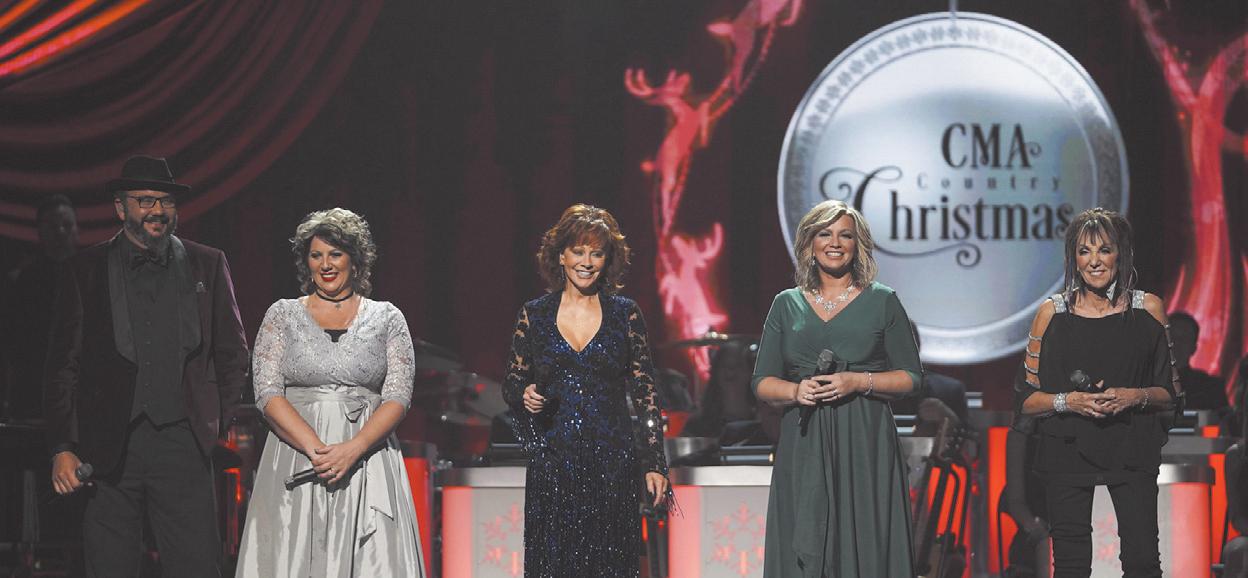
path it takes. Lionel Barrymore’s
Mr. Potter and Henry Travers’
Clarence the angel are part of the journey.
– CMA Country Christmas, ABC. Host Reba McEntire is joined by

Tony Bennett, Brett Eldredge, Amy Grant, Diana Krall, Martina McBride, Brad Paisley, The Isaacs and others, with classic songs and new collaborations part of the two-hour show.
– Pentatonix: A Not So Silent Night, NBC. The vocal group is joined by Kelly Clarkson, the Backstreet Boys, Maren Morris and Penn & Teller on a musical exploration of Las Vegas.
– Darci Lynne: My Hometown Christmas, NBC. Singer-ventriloquist Darci Lynne Farmer, an America’s Got Talent champion, celebrates with guests including Kristin Chenoweth, Toby Keith, Hunter Hayes and electronic violinist Lindsey Stirling.
– Christmas with the Mormon Tabernacle Choir, PBS. Actresssinger Sutton Foster is the guest artist and Hugh Bonneville (Downton Abbey) is the narrator for an evening including carols and a reading of the Christmas story from the Book of Luke.
– Great Performances from Vienna: The New Year’s Celebration 2019, PBS. Bonneville is back as host of this Vienna Philharmonic concert with conductor Christian Thielemann, featuring Strauss
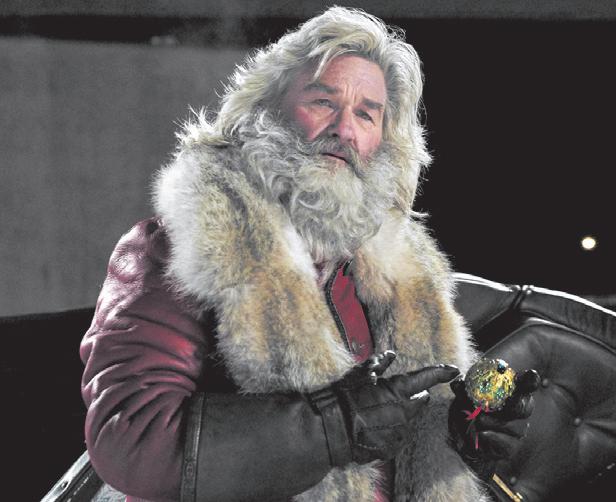
family waltzes and the Vienna City Ballet.
– Great Performances: Irving Berlin’s Holiday Inn – The Broadway Musical, PBS. A stage adapta-

tion of the 1942 movie features White Christmas and more of Berlin’s score.
– A Charlie Brown Christmas, ABC. Charles M. Schulz’s timeless crew is back in the 1965 special that finds Charlie Brown confronting the materialism of Christmas with the help of Linus and, less successfully, Lucy.
– Lidia Celebrates America: A Heartland Holiday Feast, PBS. Renowned chef Lidia Bastianich hits the road to seek holiday inspiration from different cultures and regions.
– A Home for the Holidays: The 20th Anniversary, CBS. The spotlight is again on adoptions of children in foster care, with families sharing their stories and music stars providing the soundtrack.
– A Christmas Story Live!, Fox. Maya Rudolph, Matthew Broderick and Jane Krakowski star in this repeat airing of the 2017 TV musical inspired by the 1983 movie and a Broadway production. Andy Walken plays BB-gun loving Ralphie.
– Live from Lincoln Center: New York Philharmonic New Year’s Eve with Renee Fleming, PBS. The orchestra and opera great Fleming join in a celebration of classical music and dance.
– NBC’s New Year’s Eve, NBC. Hosts Carson Daly and Chrissy Teigen will be joined by Leslie Jones in New York City, with Keith Urban hosting and performing from Nashville’s Bicentennial State Park. More artists were to be announced.
– Dick Clark’s New Year’s Rockin’ Eve with Ryan Seacrest 2019, ABC. The special hosted by Seacrest promises five-plus hours of performances.
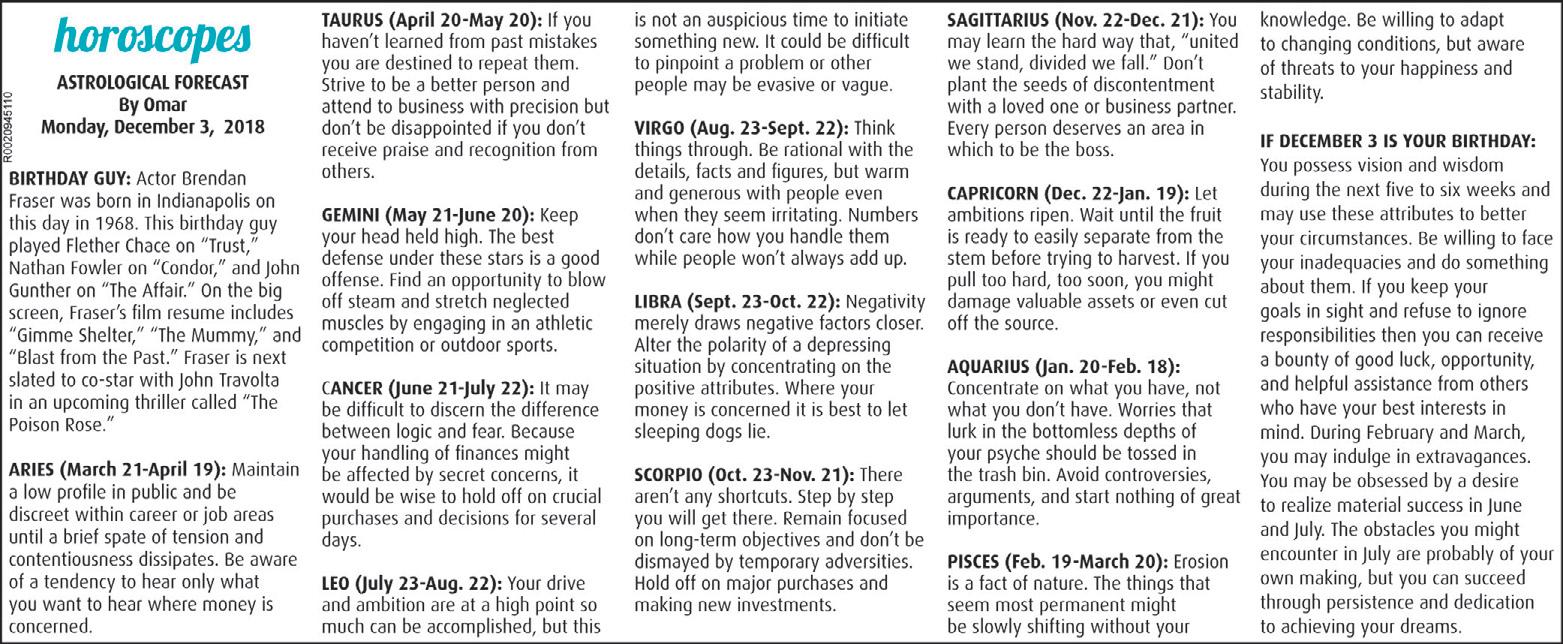



Henrik Rafaelsen and Alba August star as Reinhold Blomberg and Astrid Lindgren as lovers who can’t be together in Becoming Astrid. Lindgren went on to become a bestselling author of the Pippi Longstocking series.
Michael O’SULLIVAN Citizen news service
The Swedish author Astrid Lindgren (1907-2002) is beloved around the world for her best-selling children’s books (most notably Pippi Longstocking), but Becoming Astrid doesn’t primarily concern itself with how she got to be a famous writer.
The film, in Swedish and Danish with English subtitles, centres on the protagonist’s late teens and early 20s – when she was still known by her maiden name, Ericsson. The engrossing film by Danish director Pernille Fischer Christensen tells the story of Astrid’s affair with a married employer Reinhold Blomberg, the editor of the small-town newspaper where the 19-year-old had taken a job as a secretary and sometime reporter.
The resulting pregnancy and the birth of her son, Lars – who was sent to Denmark for several years, where he was looked after by a foster mother – forms the spine of this captivating story, which is both a feminist coming-of-age tale and a romance, though not the kind you think.
Although much of the film concerns Astrid’s efforts to reunite with her little boy and marry his father (Henrik Rafaelson), the real love story takes place between Astrid and her child, who must remain apart from her until she can afford to raise him herself.
Complications and delays arise when her married lover is unable to obtain a quick divorce.
This familiar-sounding melodrama works because of the extraordinary performance, in the title role, by Alba August, a young actress whose every emotion is made manifest, like passing clouds or a burst of sunshine, on her uncannily expressive face. This being the late 1920s, when an illegitimate child was a scandal indeed, Astrid is an usually confident, convention-flouting free spirit, given her fierce determination to keep and raise her son, married or not. Becoming Astrid is structured within an unusual framing device. The film begins in 1987, with an actress (Maria Fahl Vikander) playing the writer on her 80th birthday, opening cards and letters from young fans of her books. Those messages – which call attention to Lindgren’s special affinity for the psychology of children, and her books’ spirit of youthful resilience and independence even through tragedy – are read aloud at various points throughout the film, underscoring the connection between the facts depicted on-screen and Lindgren’s inspirational fiction. At times, this linkage feels overly on-the-nose, but the gimmick ultimately works more than it doesn’t. Pippi Longstocking has sometimes been called an icon of feminist girl-power. If Becoming Astrid makes anything clear, it’s that the character’s creator was something of one herself.
— Three stars
Citizen news service
LOS ANGELES — A Hollywood writer and director has announced the death of his wife and longtime collaborator, Gloria Katz, who co-wrote American Graffiti and helped give Princess Leia her power in Star Wars. She was 76.
Willard Huyck said Katz died on Sunday at Cedars-Sinai Medical Center in Los Angeles after battling ovarian cancer.
The couple shared an Oscar nomination with director George Lucas for American Graffiti and secretly doctored his script for Star Wars. The Reporter quoted Katz as saying they shaped Carrie Fisher’s Leia into someone who “can take command,” not “just a beautiful woman that schlepped along to be saved.”
They also wrote the screenplay for Steven Spielberg’s Indiana Jones and the Temple of Doom, which Lucas produced, and later co-wrote Lucky Lady, Messiah of Evil, French Postcards, Best Defence, Howard the Duck and Radioland Murders.
Born in Los Angeles on Oct. 25, 1942, Katz majored in English at the University of California, Berkeley, then earned a masters in film at UCLA. In 1969, she married Huyck, a college friend of Lucas at the University of Southern California.
The Reporter quoted Katz as saying in a 2017 interview that Lucas wanted her husband “to write about cruising for American Graffiti, and I sort of came with the package.”
She said Lucas had “a lot of reservations” about his Star Wars script as filming was about to begin.
“He said, ‘Polish it – write anything you want and then I’ll go over it and see what I need,”’ she said. “George didn’t want anyone to know we worked on the script, so we were in a cone of silence.”
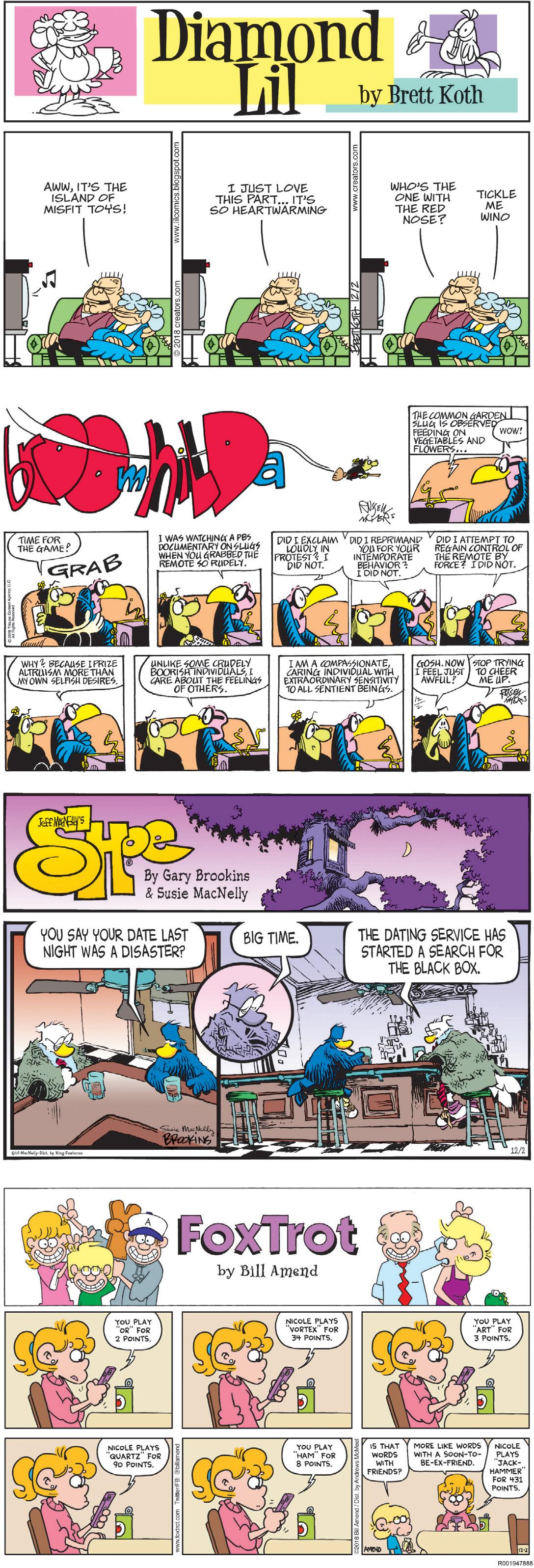


Author Shaughnessy Bishop-Stall spent the better part of a decade studying the complex state of post-drunk hell, and how to cure it.
Book details the quest for a hangover cure
Rachel ROSENBLIT Citizen news service
Hungover: The Morning After and One Man’s Quest for the Cure
By Shaughnessy Bishop-Stall
Forget death and taxes: Hangovers may be society’s most brutal equalizer. After a night of being, um, overserved, few are safe from the internal havoc that ensues, as your inflamed, free radical-swarmed organs stop releasing toxins or absorbing nutrients, your hydration-starved brain shrinks and swells inside your skull, and your liver exacts a gnarly revenge by releasing toxic compound acetaldehyde – leaving you to start cutting desperate bargains with whichever god you pray to (even, and especially, the porcelain one).
Author Shaughnessy Bishop-Stall spent the better part of a decade studying the complex state of postdrunk hell for Hungover: The Morning After and One Man’s Quest for the Cure.
He doesn’t just delve into the chemical science of hangovers; he also mixes personal memoir with some of history’s most storied mornings after. It seems Noah, for example, was the pioneer of the drinking binge, as well as the first man to wake up hung over, naked, mortified and enraged.
Bishop-Stall insists that hangovers should stop being viewed as some sort of cosmic punishment, and instead as a common condition worthy of a cure. After years of dogged research around the globe, he finds one – just in time for the holidays. But for end-of-year revelers who plan to forget all their cares over mulled wine and likely won’t remember to take his combination of six to 10 capsules (containing a mix of amino acids and vitamins) at the prescribed time – post-party and before sleep – he has one message: “Get over yourself and do what I say!” Guess we’d better listen up.
Q: In spite of the years you spent determined to find a hangover cure, you concede that hangovers can be viewed as necessary evils. Not to get too moralistic, but would you agree that if you’re going to tax your body the way heavy drinking does, you ought to feel somewhat toxified the next day?
A: Yeah. I think that’s one of the questions at the heart of the book. The more you can be guided away from being constantly pickled, it’s probably going to be better for your life. But why does it have to be so brutal when you’re inside it? Can’t there be a way that we can just apologize and make it stop? The flip side is: Why don’t we actually pay attention to it? It’s such a visceral and aggressive warning system that we still don’t pay attention to!
Q: You write about how, in Greek myth, the king of Athens decreed that only gods could handle straight wine, and that mortals had to mix it with water, lest they “go mad and/or die.” Ancient society certainly seemed concerned with moderation.
A: And to think how far we’ve gone! To have one ideal be that even a glass of wine – which was probably 14 per cent (alcohol) back then – be watered down to the strength of a weak beer to keep society functioning; and then to go, within a hundred years, to the pursuit of distillation, which was kind of like the race to the moon: Going from saying, “Wine is too strong, let’s water it down,” to “Let’s make alcohol as strong and pure as possible.”
Q: You suggest that with hangovers, timing is everything – and that if you’ve done nothing to prevent it while drinking, by the next morning it’s way too late.
A: Timing is everything! I cannot stress that enough.
Q: So what does that mean for all the morning-after IV-drip vitamin cocktails marketed as cures?
A: They’re probably one of the best ways to deal with a hangover once you’ve got one. You’re being soothed and taken care of, and if all goes well, the duration of your hangover will be shorter and the intensity will be less. But I would not consider that curing a hangover; I would consider that treating a hangover.
Q: You’ve developed your own hangover cure that currently requires swallowing six to 10 capsules. Do you plan to streamline the process? Or do you feel that the extra effort is part of earning the solution?
A: For me, once I’m taking three pills, I may as well take six – but not everybody feels that way, and certainly marketers don’t like it. Everybody tries to put (hangover concoctions) into a liquid; apparently that’s sexier.
But from my experience, what works is taking the pills, and every time I try a product that has all (the same) stuff in it, and it’s sitting in a little bottle, it doesn’t do the same thing. I don’t know why.
Q: Will you try marketing your cure?
A: I go back and forth. Everybody has gone, “Dude, if you’ve got the cure, you’re going to be a billionaire!”
At the same time, I’ve met everybody who thought that – and none of them are billionaires.
Citizen news serivce
In a large conference room in a suburban Dallas office park, three dozen employees of an American manufacturing company are standing in a circle, tossing around a bunch of imaginary balls. Some are red, they are toldothers are aqua, yellow or green. But before long the balls turn into “dirty tissues,” “dead roaches” and even a “sleeping baby.” Each time a staffer “catches” an imaginary item, he or she is supposed to say what it is and then say “thank you,” but the niceties are drowned out by laughter over the seemingly nonsensical exercise.
The game, which comes from improvisational theatre, is part of an anti-harassment corporate training workshop. It’s an opening exercise in a program to create respectful workplaces that is run by Second City Works, the professional services arm of the famous improv comedy empire.
The red ball exercise was developed in Chicago in the early 1900s by a social worker named Viola Spolin. Her son would go on to co-found Second City, the acting and comedy training ground and home to live shows where John Belushi, Steve Carell and Tina Fey cut their teeth. It is meant to teach a focus on body language (it takes concentration to keep up with all those fanciful flying objects), an acknowledgment of other people and a heightened awareness of behavior, such as automatically retracting from the delivery of an imaginary used Kleenex.
“How often did you react and think, ‘Oh, I wish I could have held onto my emotions just a little bit more,’ “ asks one of the facilitators, Rachel Miller, who occasionally performs with Second City. “That’ll be part of our discussions today: Having that awareness of how unconsciousness can come forward in times that maybe don’t best serve us.”
Second City Works, which was established in 2002, today counts companies such as Uber, Hyatt and Dow Chemical as clients. Over the past five years, the group says its client base has grown by 40 per cent. It says more than 600 clients over the past year have used its services, such as short training films or customized workshops on topics like communication, teamwork and collaboration. Second City’s overall annual revenue tops $50 million. The organization says the corporate training arm “represents a significant and growing revenue stream” within its portfolio.

Since earlier this year, it has also been adding “respectful workplace” programs to its on-site repertoire and creating anti-harassment videos for clients. Both are aimed at curbing misconduct and fostering the kind of cultures where harassment or bullying may be, at the least, less likely to happen.
In one video short that calls to mind The Office, a boss uses a biased term that a team keeps inadvertently repeating, with sound effects bleeping it out. In another, a group of co-workers stand by gossiping while a employee hits on a new staffer, but don’t take any action. While they may not be Saturday Night Live-level hilarious, the production quality and lack of awkward, groan-inducing story lines stand out compared with other stiff or poorly acted corporate training videos.
As the #MeToo movement shows no signs of abating, the Chicago-based comedy empire believes a little humour, combined with teaching corporate employees how to think with an improviser’s empathy, could help fix one of the most serious problems in today’s workplace culture.
But that’s only if corporate America doesn’t get too nervous about bringing in a group that is well-known for improv comedy to address such a delicate topic. Few of the clients Second City queried to speak with a reporter about


the anti-harassment workshops were willing to be interviewed or identified.
One company that was just days from hosting a respectful workplace training session canceled after executives decided they needed to know more about whether it might appear insensitive. Steve Johnson, president of The Second City, said, “Obviously, there’s nothing funny about this subject matter whatsoever, and we’re not trying to approach it from that standpoint.” He added that, “In our experience, very few companies are comfortable going on the record to discuss harassment training, no matter the vendor’s approach.”
But by combining lessons on what improvisers call being “others-focused,” the powerful role of “bystanders” who witness harassment and a little bit of humour, it may help the message sink in, said Kelly Leonard, the executive director for insights and applied improvisation at Second City Works.
“What we do know is comedy is an extremely effective tool if you want to talk about taboo subject matter, if you want to break down social barriers and if you want to connect people,” he said.
Research supports that idea, said Caty Borum Chattoo, a professor at American University who is working on a book about the role of comedy in dealing with social justice issues.
“Comedy, because we experience positive emotions with it, can allow us to contemplate issues differently,” she said. “It acts as an acceptable form of social critique without being defensive.”
For most comedians, of course, sexual harassment training has been a punchline – not a profit line. Ellen DeGeneres once asked her audience to guess whether a creepy script was pulled from a sexual harassment training video or a late-night adult cable movie. Carell interrupted a presentation on harassment in an episode of The Office with a topless inflat-

able doll. Cecily Strong’s Saturday Night Live sketch featuring “Claire from H.R.” spoofed the absurdity of harassment know-how that workplaces still have to teach. Yet some are trying to change that image. Earlier this year, a campaign by the Ad Council and the RAINN (the Rape, Abuse and Incest National Network) proved that videos about sexual harassment don’t have to be cringeworthy. The short video PSAs, written and directed by Sigal Avin and executive produced by Avin, David Schwimmer and Mazdack Rassi, depict cases based on real events that show credible nuances of what constitutes harassment. Several groups, from tech companies to academic institutions, have licensed the films for training, according to the Ad Council. Meanwhile, amid fears about reputational and legal damage, companies have been expanding their efforts at sexual harassment training. A survey by the Society for Human Resource Management released in January found 32 per cent of organizations made changes to their sexual harassment prevention training in the past year, and an additional 22 per cent planned to make changes this year.
One result is that more companies are going beyond the standard legal training and choosing to address the underlying office dynamics that can give rise to unreported harassment or toxic environments.
Over the past year, said Brian Kropp, vice president of the human resources group at research firm Gartner, he’s seen a big shift.
“Before, when it came to harassment training, companies would bring in employment lawyers or their outside counsel, and the purpose was to prevent the company from being sued and minimizing the legal exposure,” Kropp said.
“Now what companies are saying is that the purpose of the training is to create a better environment.”
With low unemployment and increased transparency through websites like Glassdoor, he said, it’s easier for human resource departments to build a case that cultural training is worth the investment.
Johnston is careful to say they’re not designed to replace legal compliance training – defining what constitutes sexual harassment or explaining corporate policies about reporting – but to serve as a complement. It focuses on the “importance of being a bystander and advocating for colleagues when you see that there are things that are going wrong,” he said.
In fact, only a small portion of the program directly discusses sexual harassment, and very little involves the kind of acting and

performing that many people think of when they hear the phrase “improv comedy.”
“We often have to get over the hurdle of people thinking, ‘Uh-oh, I’m at an improv workshop and I’m going to have to perform and have to be funny,’ “ Miller said. Rather, Second City’s facilitators help attendees think more like improvisers, getting them into the minds of their teammates and more aware of the unintended impact their body language or words may have.
An exercise called “What I’m Hearing Is ...” helps people rethink the way they listen to colleagues describe a problem; another called “Sit, Stand, Lean” examines how body language and positioning affects our sense of power and status.
Another one is called “Gibberish Cocktail Party,” where certain people are supposed to pretend to not like being touched during a greeting.
“It is a very light lift on improvisation,” said Butch Jerinic, another Second City facilitator who co-ran the Dallas meeting, to the group. “You’re going to work in small groups, in pairs, and as an entire group just to try on the skills that make us successful on stage.”
One company that hasn’t yet hired Second City Works for the training is Dow Chemical, but it has had them help up-and-coming leaders think about communication differences across cultures and develop inspirational speaking skills.
John Kolmer, who heads Dow’s leadership development, liked that the group has “a cache about them; people are familiar with Second City.” But “more important than that, what we find is real growth – real development – takes place when you’re out of your comfort zone.” Their sessions’ training involved putting together an improvised infomercial for a product, as well as other improv exercises. Employees “discover there’s no judgment – we’re all feeling just as wacky throwing out imaginary red balls.”
Shannon Rawski, a professor at the University of Wisconsin at Oshkosh’s business school, said it’s a good idea for employees not to be asked to play negative roles. If training “puts people into the role of harasser or victim when they play out that scene, the training itself might be a harassing experience,” she said. Her research has shown that people feel threatened even in lecture-style training about sexual harassment if they’re only offered those negative roles, prompting a backlash that can include being less able to recognize policy violations or an increase in behaviors like telling sexual jokes.
Second City’s Leonard said the goal of its program isn’t to put people into performance scenes, but to “give you the tools to be more improvisational in the moment,” he says.
“What we know about behavior change is it doesn’t work like that,” he says. “It’s a much smaller nudge. And if we can be the nudgers to get people – half that room to behave better, and the other half to be able to call out (bad) behavior – I think we’ll have done God’s work.”

On her birthday, Nancy Traylor received an unwelcome surprise. The real estate agent and her husband were about 90 minutes from home, when she checked her cellphone and saw video of someone on her front porch stealing a package. The unexpected delivery turned out to be a gift sent by a friend.
Porch pirates. Lawn looters. Backyard bandits. Whatever you call them, these criminals are brazen and opportunistic, boosting interest in video doorbells. Traylor credits hers for aiding police in nabbing the thief.
When Jamie Siminoff invented what is now the Ring doorbell in 2012, he could hardly anticipate
that, six years later, consumer spending on “smart” doorbell cameras would top $530 million US, according to Strategy Analytics. The market researcher forecasts that more than 3.4 million video doorbells will be sold this year, with the United States accounting for the majority of sales.
At their most basic, smart doorbells stream real-time video to your smartphone, tablet or desktop, showing you who is at your doorstep and allowing you to speak with them. Throw in motion detection, cloud video storage, floodlights and sirens, and you are “always home no matter where you are,” Siminoff says.
After someone broke into his house while he was on the road, Steve Ludwig researched home-
security options. Concerned about the cost of a traditional wholehouse system, he instead installed a Ring video doorbell and floodlight cameras. Six days later, while traveling again, Ludwig received an alert on his phone that someone was at his front door.
“I could see a truck pull in the driveway. This guy dressed as an air conditioner repairman walks to my backyard,” he says.
“I switched to the back camera and watched him peer in the windows and rattle the backdoor handle. So I turned on the audio feature and yelled, ‘Hey dude, get out of my yard – the cops are on the way.’ He fled to his truck and drove off.”
Within minutes, Ludwig was sharing images of the suspect
and his vehicle with the Volusia County Sheriff’s Office. Less than 90 minutes later, a deputy spotted the truck and pulled it over, later arresting the perpetrator on several active warrants. He remains in jail, awaiting trial.
“The cost of a home-security system deterred me for years, but I’m tech-savvy enough to use an app on my smartphone,” Ludwig says.
“If I had a video doorbell the first time I was robbed, I’m 100 per cent sure the police would have caught them, too.”
Many law enforcement agencies have become fans of video doorbells, so much so, that some American departments offer programs in which residents can register their home video cameras. “If something happens in your area,
we will contact you and ask you to look at the video on a specific date,” says Matthew Lee, a crime analyst for the Longmont, Colorado, Public Safety Department.
“Then, if you spot something, you send us the clip so we can try and identify the suspect or vehicle.”
Often the best evidence isn’t of the crime itself, but video of pathways and streets leading into and out of the scene. Lee recalls a video that helped crack the case of a nighttime burglary and auto theft.
Though the video was shot a block and a half away, it allowed his office to determine the crime’s time frame and identify the thieves’ vehicle. Longmont police were able to make arrests and recover some of the stolen items.
Citizen new service
Want to trim your heating costs this winter? Learning how to effectively use your house’s thermostat can help you slash those utility bills.
Though steps such as sealing air leaks and changing furnace filters can help you conserve energy, knowing how to wield your home’s thermostat is one of the best ways to clamp down on the costs of heating.
Here’s what you need to know about thermostats to stay warm this winter without overheating your budget.
A manual thermostat is the oldfashioned variety that lets you adjust the temperature in your house by moving a needle or by pressing “up” and “down” buttons. These thermostats are common in older homes, and they may be sufficient for people who spend most of their time at home but a simple thermostat can be replaced by a programmable or smart thermostat – maybe even by yourself. And if you’re not confident in your DIY skills, most manufacturers offer professional installation, though it can be costly.
A programmable thermostat is essentially a “set-it-and-forget-it” product that lets you control when your home’s heating or air-conditioning system turns on according to a preset schedule.
Proper use of a programmable thermostat can save the average household hundreds of dollars per year in energy costs. For most homeowners, a programmable thermostat is worth the upfront investment.
A smart thermostat offers even greater convenience. Typically, these devices enable you to adjust your home’s thermostat remotely from an app on your phone. Some

can even detect when you’re away from your house by tracking your phone’s location.
“If you’re gone, (a smart thermostat) can set the temperature to an energy-saving ‘away’ setting. Then, when it detects you are back in your home, it will resume the regular temperature setting,” says Eric Blank, editor at the Smart Cave, a smart-home product review website. “This can be a big energy saver.”
Some smart thermostats will also connect to your home’s voice assistant – meaning you can tell
Alexa to adjust the heat without leaving your couch.
But, smart thermostats aren’t right for everyone.
The best candidates for smart thermostats are people who leave their house often, since they can raise or lower their heating and cooling as need be.
Naturally, smart thermostats are also better suited for homeowners who are tech-savvy.
So, how can you tell if you’re ready to go smart?
If you set up your home wireless router yourself, you should be able
to learn how to operate a smart thermostat without losing your mind.
No matter what type of thermostat you have, you should be adjusting your home’s temperature before you sleep. Indeed, you can save as much as 10 per cent a year on heating and cooling by adjusting your thermostat setting by several degrees from its normal setting for eight hours a day.
If your house has more than one heating or cooling zone, installing a separate thermostat for each system can help you save more money, because some rooms (such as the basement or attic) tend to require more heating or air conditioning than others.
In addition, you’ll want to install your thermostat away from heating or cooling registers to ensure it gets an accurate reading. A thermostat placed in the kitchen, for example, could make your device “think” your house is warmer than it truly is.






Mary Rose Foreman (Redmond) May 13, 1928 - Nov 19, 2018 Mary passed peacefully in her 90th year after living a full & active life. Mary had an indomitable spirit and after Stewart died, she returned to college at the age of 45 to become an Licensed Practical Nurse. She left that career to work at Sears in the Catalog Department and then onto Credit Card Promotion where she won a number of Top Customer Service awards. She was an avid golfer, playing in the Senior BC Summer Games and scoring a hole in one in her 70’s despite being blind in one eye & half blind in the other. She also loved to travel both locally and afar and when she no longer could, she travelled vicariously thru her children & grandchildren. Mary was also a dedicated community volunteer including over 25 years at the Hospital Auxiliary. When her children left home to start their own lives & families, her home remained the gathering place for holiday celebrations. Mary worked hard to keep her family connected over the miles & thru the years. She is predeceased by her 1st husband Stewart Redmond, 2nd husband Patrick Foreman, daughter Judith, sons Sydney, Michael & Darcy. She is survived by her children Robert, Darryl, Donna (Art), Greg (Kathy), Shelly (Noel), 13 grandchildren, 16 greatgrandchildren & 2 great-great-grandchildren. A Celebration of Life will be held in the spring/summer of 2019 to allow Mary’s many far flung family & friends to attend. Notification of the date will be published in the PG Citizen. In lieu of flowers please donate to the compassionate Prince George Hospice House.





Joinourteam!Thesuccessfulcandidatewillhavea minimumof5yearsofficeandfullcyclebookkeeping experience,andbeabletopassawrittenand practicaltest.NDTofficeexperienceanasset.Email orcalltorequestadetailedjobdescription. Call:236-423-0447Email:office@horizontesting.ca
‘An end to an era...’ The Chimilowski Girls
Marie Jackson, has gone on to join her sisters, Rose, Victoria, Helen, Ann, and Daisy. 21st November 2018, 97 years young. Also predeceased by her husband Robert Lloyd George Jackson in 1969. Loved and remembered by her son Robert (Glenis) Jackson and her daughter Linda (Leo) Schwab. She will be greatly missed by her five grandsons and their wives, two greatgranddaughters, and five great-grandsons, and many, many nieces and nephews. She was born 9 October 1921 in Prince George, B.C. She lived under the Cutbanks with her parents Tomasy and Wasylena Chmielowski (Chimilowski) and her sisters. Living in a small house on 7th Avenue, her home was always open to family and friends. She loved to garden, her flower beds were always beautiful, especially her gladiolas. She belonged to the Horticultural Society in the past and won many awards with them as well as at the Fall Fair. She was well known for her baking , especially her pies and her shortbread, her chicken soup, and playing her lottery tickets... She always remembered birthdays (putting small poems in with the cards), and anniversaries of her family, children, grandchildren, sisters, brothers-inlaw, nieces and nephews, even phoning and singing ‘Happy Birthday’. She was independent to the end and always did things her way. She died in her sleep after a short stay at Hospice house. Thanks to ‘the girls’ at Gateway Lodge and Hospice House, and Dr. Tammy Attia for all your care. She loved you all. A former employer, was recently quoted, saying “They don’t make women like ‘Jackson’ any more”. No service by request.
Home (250)997-5538 Cell (250)990-0152













































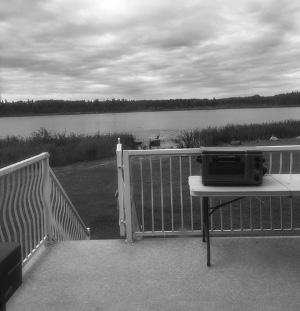














Currencies
OTTAWA (CP) — These are indicative wholesale rates for foreign currency provided by the Bank of Canada on Friday. Quotations in Canadian funds.
Matt O’BRIEN Citizen news service
Microsoft’s big bet on cloud computing is paying off as the company has surpassed Apple as the world’s most valuable publicly traded company.
The software maker’s prospects looked bleak just a few years ago, as licenses for the company’s Windows system fell with a sharp drop in sales of personal computers.
But under CEO Satya Nadella, Microsoft has found stability by focusing on software and services over the internet, or the cloud, with long-term business contracts.
That 1990s personal-computing powerhouse is now having a renaissance moment, as it eclipses Facebook, Google, Amazon and the other tech darlings of the late decade.
Apple had been the world’s most prosperous firm since claiming the top spot from Exxon Mobil earlier this decade. Microsoft surpassed Apple briefly a few times this week, but didn’t close on top until Friday, with a market value of $851 billion to Apple’s $847 billion. Microsoft hadn’t been at the top since the height of the dot-com boom in 2000.
Microsoft became a contender again in large part because Apple’s stock fell nearly 20 per cent in November, while Microsoft hasn’t done any worse than the rest of the stock market. But the fact that it hasn’t done poorly is a reflection of its steady focus on business customers in recent years.
TORONTO (CP) — Canada’s main stock index closed the month on a slightly positive note Friday even though the energy sector was hit by a 22 per cent drop in crude oil prices in November, the worst month in more than a decade. Despite weaker Canadian growth in third-quarter economic activity and consumer spending, and a focus on U.S. President Donald Trump’s weekend meeting with China’s Xi Jinping, oil again took centre stage.
The January crude contract lost 52 cents to US$50.93 per barrel, down from $65.31 at the start of the month. It has fallen by more than 30 per cent from $73.25 at the start of October.
“It’s quite a big drop,” says Kevin Headland, senior investment Strategist at Manulife Investments. “Expectations were that when it hit $75 that it was going to continue to climb and I think that was probably an overestimation of the actual conditions of supply-demand fundamentals.”
While November’s price decrease was steep, it was affected by the timing of oversupply conditions amid unexpected waivers on Iranian sanctions and a slowdown in global economic growth, he said. Uncertainty remains heading into next week’s OPEC meeting when some expect Saudi Arabia to increase production to get some supply balance back into the market.
That should allow oil prices to bounce back, but not to $75 a barrel, Headland said.
“I think with a slow economic growth environment I don’t see how it can unless you get undersupply conditions and I don’t think that’s going to happen either with shale pumping out at record levels.”
The energy sector was the worst performer on the day, losing almost one per cent in Toronto. Health care led on the upside, rising 1.4 per cent, followed by industrials.
The S&P/TSX composite index ended the day up 3.78 points to 15,197.82. In New York, the Dow Jones industrial average rose 199.62 points to 25,538.46. The S&P 500 index was up 22.23 points at 2,759.99, while the Nasdaq composite was up 57.45 points at 7,330.54.
The Canadian dollar traded at an average of 75.18 cents US compared with an average of 75.33 cents US on Thursday.
The January natural gas contract was down 3.4 cents US$4.61 per mmBTU.
The February gold contract was down US$4.40 at US$1,226 an ounce and the March copper contract was down 0.2 of a cent at US$2.79 a pound.
Microsoft lost its lustre as people were shunning PCs in favour of smartphones. In 2013, PC sales plunged 10 per cent to about 315 million, the worst year-to-year drop ever, according to research firms Gartner and IDC. It didn’t help that Microsoft’s effort to make PCs more like phones, Windows 8, was widely panned.
But a turnaround began when the Redmond, Wash., company promoted Nadella as CEO in 2014. He succeeded Microsoft’s longtime CEO, Steve Ballmer, who initially scoffed at the notion that people would be willing to pay $500 or more for Apple’s iPhones.
That bet paid off. Windows is now a dwindling fraction of Microsoft’s business. While the company still runs consumer-focused businesses such as Bing search and Xbox gaming, it has prioritized business-oriented services such as its Office line of email and other workplace software, as well as newer additions such as LinkedIn and Skype. But its biggest growth has happened in the cloud, particularly the cloud platform it calls Azure. Cloud computing now accounts for more than a quarter of Microsoft’s revenue, and Microsoft rivals Amazon as a leading provider of such services.
Wedbush analyst Dan Ives said Azure is still

While the tech carnage seen over the last month has been brutal, shares of (Microsoft) continue to hold up like the Rock of Gibraltar.
— Wedbush analyst Dan Ives
in its early days, meaning there’s plenty of room for growth, especially considering the company’s large customer base for Office and other products.
“While the tech carnage seen over the last month has been brutal, shares of (Microsoft) continue to hold up like the Rock of Gibraltar,” he said.
Being less reliant on consumer demand helped shield Microsoft from holiday season turbulence and U.S.-China trade war jitters affecting Apple and other tech companies.
U.S. President Donald Trump amplified those tariff concerns when he told The Wall Street Journal in a story published late Monday that new tariffs could affect iPhones and laptops imported from China.
The iPhone maker had already seen its stock
fall after reporting a mixed bag of quarterly results in early November amid fears about how the technology industry will fare in the face of such threats as rising interest rates, increased government regulation and Trump’s escalating trade war with China. Apple also spooked investors with an unexpected decision to stop disclosing how many iPhones it sells each quarter. That move has been widely interpreted as a sign that Apple foresees further declines in iPhone sales and is trying to mask that.
While smartphones caused the downturn in personal computers years ago, sales of smartphones themselves have now stalled. That’s partly because with fewer innovations from previous models, more people choose to hold on to the devices for longer periods before upgrading.
Daniel Morgan, senior portfolio manager for Synovus Trust, said Microsoft is outperforming its tech rivals in part because of what it’s not. It doesn’t face as much regulatory scrutiny as advertising-hungry Google and Facebook, which have attracted controversy over their data-harvesting practices. Unlike Netflix, it’s not on a hunt for a diminishing number of international subscribers. And while Amazon also has a strong cloud business, it’s still more dependent on online retail.
Dan HEALING Citizen news service
CALGARY — A rift in the western Canadian oilpatch over how to best deal with a glut of oil blamed for wide discounts in local spot prices continues to widen despite the province’s vow this week to buy locomotives and railcars to help drain the surplus.
Alberta Premier Rachel Notley said in speeches in Ottawa and Toronto this week that the province has decided to buy as many as 80 locomotives and 7,000 rail tankers – expected to cost hundreds of millions of dollars – to move the province’s excess oil to markets, with the first shipments expected in late 2019.
But that will take too long and doesn’t help with Canada’s inability to build new pipelines, which is the root of the problem, said Jim Riddell, chairman and CEO of Paramount Resources Ltd., on Friday.
“It’s (a government) problem that they created and they have to fix it,” said the normally media-shy CEO in an interview.
“They need to, in the short term, curtail production for both gas and oil. They have to do it thoughtfully so that it influences producers to shut in the lowest
value production and not shut in the highest value.”
The intermediate-sized company was looking at raising its drilling budget next year to increase production but has changed its outlook in the last six to eight weeks to instead favour spending “a small fraction” of its 2018 budget of $600 million because of poor prices, Riddell said.
The curtailment plan first put forward by oilsands giant Cenovus Energy Inc. was supported this week by Jason Kenney, leader of Alberta’s opposition United Conservative Party, who suggested all companies in Alberta be forced to temporarily halt 10 per cent of their production.
Western Canada had total production of about 4.3 million barrels per day of oil in September.
Curtailment is opposed by Calgary-based companies such as Suncor Energy Inc., Imperial Oil Ltd. and Husky Energy Inc. whose refining assets and firm pipeline contracts allow them to avoid most local price discounts.
On Friday, Imperial and Husky said they remain opposed to involuntary production cuts but support the rail investments because they could help to improve market access.
“Any and all actions that can be taken to increase takeaway
Potential customers are reading this ad right now.
capacity are ultimately in the best interest of our industry,” said Imperial spokeswoman Lisa Schmidt in an email.
In Friday’s fiscal update, the Alberta government says it now expects growth of 2.5 per cent in 2018, down from the 2.7 per cent growth forecast last spring, because of lower commodity prices. It says discounts on crude oil are costing the country $80 million a day in lost revenue.
It has appointed a panel to find solutions to low oil prices and says it hasn’t ruled out using curtailment or adjusting its royalty scheme, through which it gets a cut of any oil or gas produced from lands where it owns the mineral rights, if necessary.
The CEO of well completion firm Trican Well Service Ltd. says he, too, is supporting production cuts even though they could translate into a short-term drop in activity this winter, the season when most drilling in Western Canada is done because the frozen ground allows access to remote sites.
“If the current situation stays where it’s at, I think the industry could be in for a pretty a significant 2019 (spending) cut,” said Dale Dusterhoft on Friday, adding he doesn’t normally support government intervention in the market.
Security breach exposed data of 500M Marriott guests
NEW YORK (AP) — A security breach inside the Marriott hotel empire compromised the information of as many as 500 million guests worldwide, exposing their credit card numbers, passport numbers and birth dates for as long as four years, the company said Friday. The crisis emerged as one of the largest data breaches on record. Analysts were alarmed by the length of time the breach had been going on. Many security breaches span months, an average of 90 to 200 days, but this one began in 2014. The affected hotel brands were operated by Starwood before it was acquired by Marriott in 2016. They include W Hotels, St. Regis, Sheraton, Westin, Element, Aloft, The Luxury Collection, Le Meridien and Four Points. None of the Marriott-branded chains were threatened. For as many as two-thirds of those affected, the exposed data could include mailing addresses, phone numbers, email addresses and passport numbers. Credit card numbers and expiration dates of some guests may have been taken, according to the company.

Did Albert Einstein believe in God? The physicist was constantly questioned about his religious beliefs during his lifetime. Two Einstein artifacts being auctioned in New York could contain clues to the spiritual beliefs of the 20th century’s bestknown thinker.
Sotheby’s is auctioning a Bible Friday in which Einstein inscribed in 1932: “This book is an inexhaustible source of living wisdom and consolation.”
Christie’s, meanwhile, is auctioning a 1954 letter on Tuesday in which Einstein declared, “The word God is for me nothing more than the expression and product of human weaknesses, the Bible a collection of honourable but still primitive legends.”
The Bible being auctioned was a gift from Einstein and his wife, Elsa, to Harriet Hamilton, an employee of the couple. The leatherette-bound English-language Bible is inscribed in German by Einstein and is expected to sell for $200,000 to $300,000, said Cassandra Hatton, a specialist in books and manuscripts at Sotheby’s.
Hatton said it’s hard to reconcile the description of the Bible as a source of “living wisdom” with the harsher view of religion that Einstein expressed elsewhere.
“It’s possible that this gift was given to someone who was quite religious,” Hatton said. She speculated that Einstein might have penned the inscription “out of respect for her religion.”
The letter Christie’s is selling was written the year before Einstein’s 1955 death and was addressed to Eric Gutkind, a philosopher who had written a book about Jewish spirituality and the pursuit of science.
Einstein wrote in German that while he “gladly” belonged to the Jewish people, he believed that the Jewish religion “like all other religions is an incarnation of the most childish superstitions.”
Christie’s books and manuscripts specialist Peter Klarnet said the letter, which carries a presale estimate of $1 million to $1.5 million, is notable for its bluntness.
“Here he is actually quite blunt in what he says,” Klarnet said. “The word ‘God’ is a product of human weakness.”
Both items have come up for auction before. The Bible sold for $68,500 at Bonham’s in New York in 2013 and the letter to Gutkind sold for $404,000 at Bloomsbury Auctions in London in 2008.
Walter Isaacson, the author of the 2007 biography Einstein: His Life and Universe, said the great man’s views on religion are hard to pin down.
“Einstein generally avoided giving simple answers, and like most human beings his feelings about spirituality varied over time,” Isaacson said. “Sometimes he expressed himself in more spiritual terms and sometimes he was more of a debunker of religion.”
As Isaacson recounts in the book, everyone from clerics to schoolchildren quizzed Einstein about his religious views. A New York rabbi sent a telegram demanding, “Do you believe in God? Stop. Answer paid. 50 words.” Einstein answered, “I believe in Spinoza’s God, who reveals himself in the lawful harmony of all that exists, but not in


a God who concerns himself with the fate and the doings of mankind.” Isaacson said it’s not surprising that Einstein’s faith or lack thereof sparked so much interest.
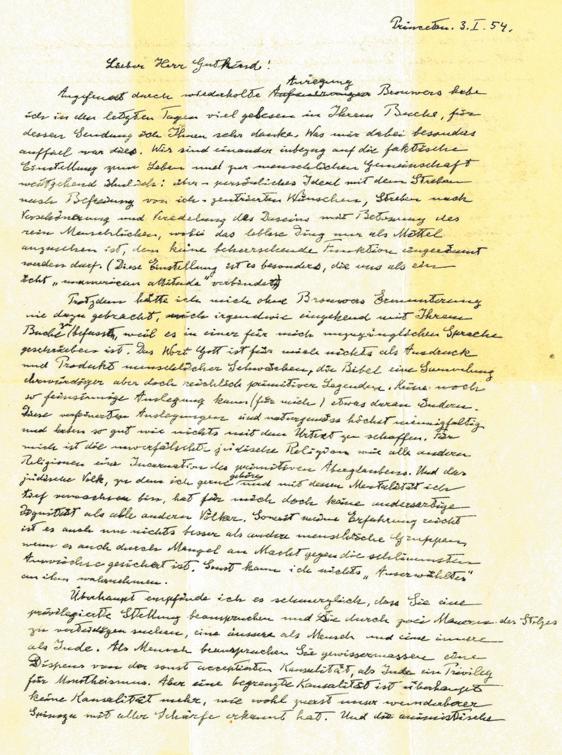
“There was a delightful belief that a genius who could fathom the laws of the universe could give us the answer to timeless questions such as about the existence of God,” Isaacson said. “And many people
were hungering for a way to reconcile science and religion. They were hoping that he would say, ‘Yes, there is a God. You can quit worrying about it now.’ But his beliefs were not that simple.”
On Nov. 25, we welcomed Pastor Jordan Gadsby to our church to share stories from his experience with the Humboldt Broncos.
Pastor Jordan is from Nipawin, Sask., which is about 20 minutes away from the home of the Humboldt Broncos hockey team. In previous years, Pastor Jordan had helped the Broncos a few times with media items like fixing a microphone and getting them a computer cord to assure their media screens could play during the games. These small acts of
kindness built a relationship that would become instrumental to healing in later years.
You see, because Pastor Jordan had taken a few minutes out of his day to help the Broncos with some media technical items, on April 6, when the Broncos team bus was in a horrific accident, they called on Pastor Jordan and his church to be a place of refuge. The Broncos hockey rink was full that night, waiting for a hockey game to
start. Then the accident happened and the staff of the Broncos were scrambling to find a place people could go as they awaited news of the medical status of their family members that were traveling on that bus. Pastor Jordan had just gotten home from a busy day and received the call from the Broncos, turned around and went and opened his church doors and put on a pot of coffee. He shared with us Sunday that he sat with many families that night, praying and waiting for news of their family members. This was a horribly dark time as so many lives were lost and tragedy hung thick in the air. But because
of kindness, because of a relationship that was forged by providing a microphone and computer cord, Pastor Jordan and his Nipawin church were able to love their community in one of their most tragic seasons. They provided meals for first responders and families affected by the tragedy. This was a moment when it would have been understandable to crawl up in a ball and just grieve, but instead this community rallied around their people, loved them and shone God’s light into the darkness. They prayed with them. Cared for them. And through small acts of kindness, showed them the lavish love that
God has for every one of us. I’m inspired by this story in my own life, to see opportunities to love people. Not in grand exuberant ways that are flashy, but in small meaningful ways that reveal God’s goodness and love. I’m reminded that building relationships is life giving to us both. I’m encouraged to see hope rise up and be the voice among the people. And I’m thankful that I live in a small town that cares for one another. I pray you won’t walk by someone hurting today, but will stop, take a moment, and shed some light into their dark world. I pray today we will both show them God’s love.
